Turquoise Energy News #167
covering April
2022 (Posted May 8th 2022)
Lawnhill BC Canada - by Craig Carmichael
www.TurquoiseEnergy.com
= www.ElectricCaik.com
= www.ElectricHubcap.com
Month
In
"Brief"
(Project Summaries etc.)
- Spring Gardening - Plastic Recycling 2.0 - Solar PV Addition - Worth
of Solar PV? - More On Solar PV... & Latitude - Huge Duct Fan -
Lithium Iron Phosphate Batteries Arrive
In
Passing
(Miscellaneous topics, editorial comments & opinionated rants)
- Food Shortages? - Ukraine... A.K.A. USA (by proxy) Versus Russia -
Smol
Thots - ESD
- Detailed
Project Reports
-
Electric
Transport - Electric Hubcap Motor Systems [no reports]
Other "Green"
& Electric Equipment Projects
* Spring Gardening - Tiller for Lawn Tractor and Barley Patch -
Seedlings - Purchased Tomatoes - Corn - Potatoes
* Plastic Recycling 2.0 Development (for Vertical Axis Wind
& Water Plant, multi-use flat sheets)
Electricity Generation
* My Solar Power System:
- Not So Great Grid Ties? (Hmm... they seem pretty good after
all!)
- Three New Solar Panels: On Carport Roof (sunniest place of all)
- Daily/Monthly
Solar Production log et cetera - Monthly/Annual Summaries,
Estimates, Notes
Spring Gardening
There's ever more talk of looming food shortages. I don't
want to have any part in it (especially to be hungry), so my main focus
for the month
was again on gardening and I put much time and energy into it. More big
spruce roots were dug out of the main garden. Much got planted by May
2nd (An English walnut tree, onions, 8 raspberries, 2 blueberries,
cabbages, several sunflowers, zucchini, squash, corn in the greenhouse
and lots and lots of potatoes). Much more should be done. From aosom.ca
for about 265$C total ("free shipping") I ordered and quickly received
a 3 by 4.5 meter greenhouse kit to have extra space for potted plants.
The lateness of this report is indicative of the energy
& time I've been putting into food planting this spring and I
apologize for any bad or messy editing herein. (more details under
"Other Projects")
Plastic Recycling 2.0
 I
did a bit more on PP plastic recycling - making the big rectangular
pieces - and I found the oven definitely
needs a temperature control. After one nice molding that went smoothly
I thought "Great!", but
the next one with the same oven timing (and the oven still just a
little warm
to start) actually boiled the plastic, making much smoke. The piece was
filled with bubbles and
stuck pretty hopelessly to the mold, coming off in little chunks.
That's it for the time being until I get the mold cleaned up and put in
controls both for temperature and for time. (I do have them.)
I
did a bit more on PP plastic recycling - making the big rectangular
pieces - and I found the oven definitely
needs a temperature control. After one nice molding that went smoothly
I thought "Great!", but
the next one with the same oven timing (and the oven still just a
little warm
to start) actually boiled the plastic, making much smoke. The piece was
filled with bubbles and
stuck pretty hopelessly to the mold, coming off in little chunks.
That's it for the time being until I get the mold cleaned up and put in
controls both for temperature and for time. (I do have them.)
But I have good hopes. I'll replace the "depth setting
screws" with something like "thumbtacks" inside the mold. They can move
around a bit as the plastic cools and shrinks, so once I've put the
mold in the oven and turned it on, I won't have to attend to it again
until I remove the finished piece from cold oven and from the mold. I
can start a molding and go off and do other things.
A great discovery (owing to a broken corner on an
otherwise fine piece) was that I can glue pieces together with a hot
air gun. This opens prospects for hot air "welding" to form larger or
complex parts instead of bolting pieces together.
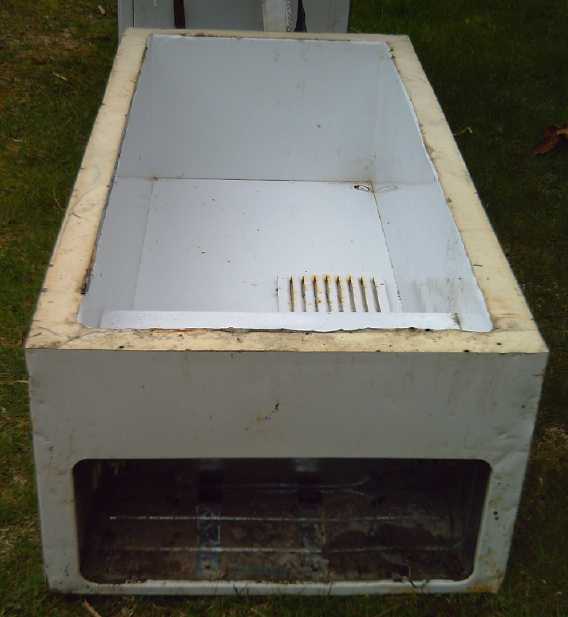 Near the start of May I found a
horribly banged up freezer at the refuse station that had a metal
inside liner instead of plastic, to use as a large oven. I cut it just
above the center and discarded the mangled top half. and the
compressor. The well insulated side walls are 2.5 inches thick. It will
hold molds up to 22 by 58 inches. Just what I wanted! Except maybe I
can go back and find another lid the same size to replace this horribly
battered one.
Near the start of May I found a
horribly banged up freezer at the refuse station that had a metal
inside liner instead of plastic, to use as a large oven. I cut it just
above the center and discarded the mangled top half. and the
compressor. The well insulated side walls are 2.5 inches thick. It will
hold molds up to 22 by 58 inches. Just what I wanted! Except maybe I
can go back and find another lid the same size to replace this horribly
battered one.
I'll mount an oven element in it and the temperature
sensor and digital control I bought some time ago, and some angle iron
"bars" to set molds on. And hook in a timed outlet. (If the pieces are
smaller I can do more than one at a time.)
(More details under "Other Projects")
Solar PV Addition
Another focus for a couple of days came to be on solar
power. I had gradually come to realize that the new carport roof must
be the sunniest place on the whole property - especially in winter. So
I started thinking about putting solar panels there some time ago, and
on the 27th and 28th with the whole summer ahead, I finally did it.
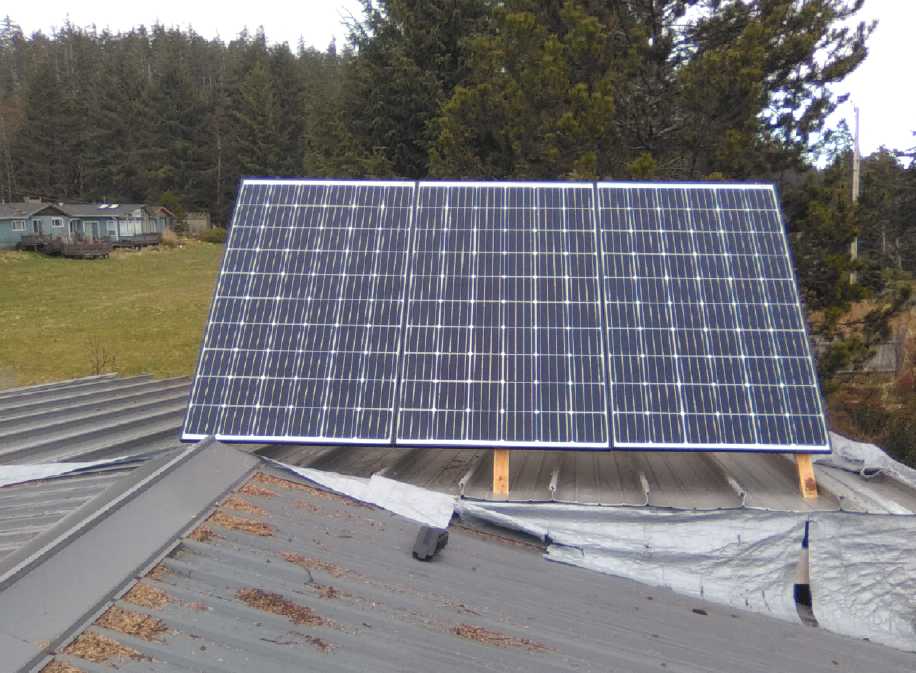
I installed the 3
panels facing south at 45° - a slope which I figure must be about
optimum year round all things considered; still very good in winter. I
had before worried about wind ripping up exposed panels, but with the
trees around, it's just not that strong around the house and yard. The
3 panels sitting on the lawn, just propped up with sticks and not
fastened, have (surprisingly) never moved or blown over in winds. There
was a good storm three days after this installation and nothing
happened to the new frame & panels.
I made a big "A" frame of 2 by 3s to
hold the panels facing south on the roof, mounted them and got
them (temporarily) wired up with a
couple of the 700W inverters inside the carport. (They do seem to work
quite well if not too heavily loaded.) So now I have 18 solar
panels working - all 305W except the oldest 4, which are each about
250. I need to install a plug-in in the carport for them.
The new ones in this favorable location are now making
around 21-27% improvement to daily production -- and that percentage
will
be substantially higher in winter. Yet 3 out of 18 is just 16.7% of the
panels. Location, location, location! From the first day they did get
more
sun and worked more
later into the afternoon than any of the other panels, which all went
into tree shadows earlier. So I hope I may never be short for at least
basic daily
essentials [fridge & freezer, evening lights, electronics...] if
the grid is down for a while even in winter with low sun
and clouds. (To that end I
also ordered another small 36VDC to 120VAC inverter just to run the
freezer, from somewhere on AliExpress.com.)
With 2-1/2 days left in the month I didn't start
including the output from the new panels in the regular readings until
May. But with it making 6.5 KWH on the sunny 30th (making the actual
total a record 26.59 KWH), I expect I'll be
making more electricity than I'm using in the 3 or 4 best summer
months. (In fact the first new readings at the start of May tend to
bear this out.)
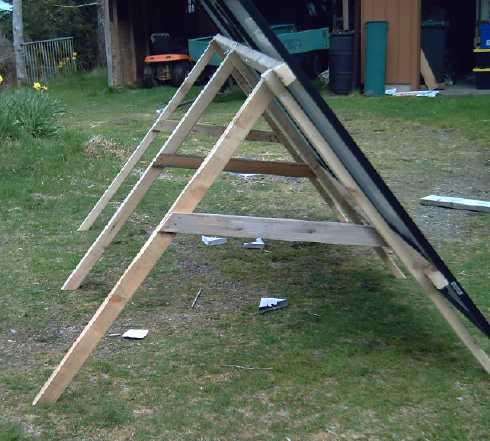 Working the Angles: They all had
to be figured
so it
Working the Angles: They all had
to be figured
so it
would sit right on the 7° slope of the carport roof.
After making sure the panels bolted on right, I took
them off and pulled it all onto the roof in four pieces.
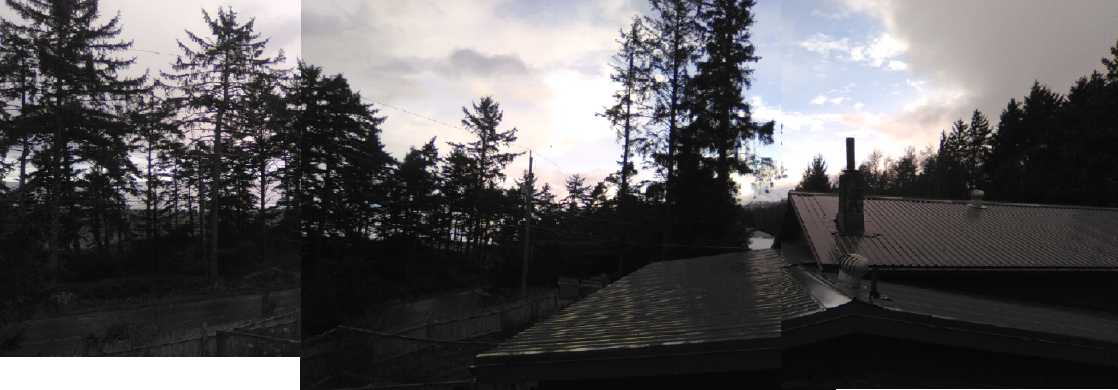
Sky view SE,
S and SW from
the new solar panels. (South is about
where the pink meets the white patch, to the left of the 3 nearby
trees.)
From here, through the best part of the day the sun should pass
above most of the trees (and the house roof) even in December.
(A few more details under "Electricity
Generation")
The Worth of Solar PV?
I've remarked before that the cloudy west coast in general
is a less
than ideal area for solar power. I thought that we got half the
annual sunshine hours here of the sunniest locales in BC. Haida
Gwaii is far enough north that for the about 3 darkest months in the
winter (November, December and January), little solar power
is generated, and beside them are 2 "border" months (October
& February) when the power output
is meager. Still, for the other 7 months when the days get long and
especially the 5 best, solar
PV panels
work so well and provide so much energy for their cost that they may be
considered
worth having. What else can consistently generate hundreds of
kilowatt-hours per month at home, with no moving parts that would need
ongoing maintenance? 30 or 40 in a good location can even pass a
megawatt-hour a month. On delving into actual figures, my saying "half
the
solar" for around here is a slightly negative exaggeration considering
better locales within Canada and especially BC.
There are about 8766 hours in a year, so about 4383
daylight hours. Looking up annual sunshine hours as listed for Canada,
it would seem that early mornings and late afternoons must be not
counted or are prorated, which makes sense for solar. It seems the
prairie provinces get the most sun, with 2200-2350 annual sunshine
hours. Much of BC gets around 1900-2100. The only figure I could
find for Haida Gwaii was for Sandspit, which seems to have the sunniest
microclimate on the islands. It was listed as 1492. Perhaps we might
take 100 off for Queen Charlotte through Tlell area and call it 1400.
Prince Rupert was about the worst in the area with 1213 (aside from
Stewart, up a cloudy Fjord with 986 - yuk!).
So a solar panel setup around here may take substantially
longer to pay for itself than in places "where the sky is not cloudy
all day" - and of course than at lower latitudes. Consider versus
Edmonton
or Winnipeg: 1400/2350, we only get 60% as much solar. Compared to the
better places in BC like Victoria or Kamloops, 1400/2100, we have 67% -
2/3 as much. (The figures say Victoria is better than I thought it was
when I lived there. I was surprised hot, dry Kamloops didn't get more.)
When compared to the driest, sunniest areas farther
south like Tuscon Arizona (3806!), Canada in general comes out well
behind, and a US average in good areas looks like around 2600 hours a
year.
So assuming static prices, "break even" might be 10 years
instead of 6, or maybe even 20 instead of 12 (depending what the
installation
cost), compared to the areas in Canada with the most sunshine. But
those investments continue to pay year after year after year for almost
free after that (presumably for decades), and the savings grow in
dollar figures with inflation and the price of electricity. So as an
investment it helps the environment and probably pays better than any
purely financial type investment has this century. And with a
little extra equipment and batteries solar can be insurance against
having no power if the grid fails, about which there have been various
warnings in recent times and the disastrous widespread failures in
Texas in February 2021.
Under "My Solar Power System" at the very bottom of this
report, I have noted the savings in electricity cost from having solar.
Over 3 years at our heavily subsidized power price of 12¢/KWH, my
system has saved just 759.37$. That is admittedly pretty small peanuts.
But 4 years ago I heard that the actual cost of electricity to BC Hydro
on Haida Gwaii (which is majority diesel generated with a small hydro
power plant when there is enough rain) was 50¢/KWH and a BC Hydro
employee recently told someone it was 1$/KWH. So the actual savings to
society as a whole is probably somewhere between 3164.51$ (mostly for
diesel fuel - 2018 prices) and 6329.02$ (total, 2022).
But it should be noted that my system was cobbled together
a little at a time with
too-thin scrap wires (an invisible but significant loss of
power), cheap plug-in 1000 watt micro grid ties (now getting a couple
of the new 1400W) and cheap plug-in AC power monitors that (luckily)
count upward whether the power is going in or out. Most of the panels
are mounted flat on the roof (15-18° slope) instead of at a more
optimal angle like
45°, and except in the best four months or so (and even then) they
get a lot of
shade. So really, not much about my system is optimal. If it was, it
would have been making more electricity but it would also have cost
more to do it "properly", running new dedicated wiring through the
house. (Too much trouble - I confess I just wouldn't have got there.)
And I would have to cut down quite a few trees.
The grid tie inverters seem pretty reliable. They must
sell millions or tens of
millions of them. I looked on line when I started, to see if there were
any reports of accidents with them. If they were unsafe to power
company crews, any accident(s)
would have surely been on the news. The one thing they don't seem to be
good at is fast recovery when the sun goes behind a cloud. They
suddenly cut right out and take a couple of minutes to gradually come
back up to full available power. By then the sun has come out - and
then dropped behind another cloud causing another reset. And rating
notwithstanding, the more power connected to them, the lower their
efficiency. They work best with just one or two panels connected. If
there are four, using two each on two inverters will add many watts
over using just one.
A power
monitor(s) is a necessity. Without seeing the power output,
there's no way to be sure everything is working. If something in the
system has quit or become disconnected and it's making less or no
power, there's no other ready indication. Plus it's good to know the
overall production.
This month, with some new inverters and a couple more
solar panels (15 total; 12 until recently) - and with some nice sunny
weather - the power my system is generating has broken all the previous
records for "most in a day" and "most for the month".. Maximum power
output hit ~2700W instead of not much over 2000. Both daily and total
monthly production also hit records (Daily, 3 times: 19.13 KWH, then
19.29, then on the 30th, 20.07. For the month, 404 KWH; previous record
329.). (Note: These figures do not include the 3 panels newly installed
on the 28th - below.)
More On Solar PV - & Latitude
Here's a take on the seasonality of the power: IN FIVE
SUNNY DAYS from April 12th to 16th my systems made
94.27 KWH - more than ANY TWO WHOLE MONTHS OF DECEMBER + JANUARY (62
days) that I've recorded for the last 3 years. Also that was more than
ANY ENTIRE MONTH of November through February (except Feb. 2022 was
slightly more). This far north (53.5°) there's little to be had in
winter unless one has a totally clear south exposure with no trees or
other shaders on the skyline, or if the solar panels are above the long
shadows those obstacles create. Even then collection will be meager in
the short days and clouds.
A house in Skidegate by the main road got about 30 solar
panels installed on a (25° slope?) south facing roof a while back.
I
hadn't realized there were so many until I tried to count them as I
drove by. Twice as many as I have. Nice! When I remarked on it someone
told me David Suzuki's daughter and her husband live there.
Huge Duct Fan
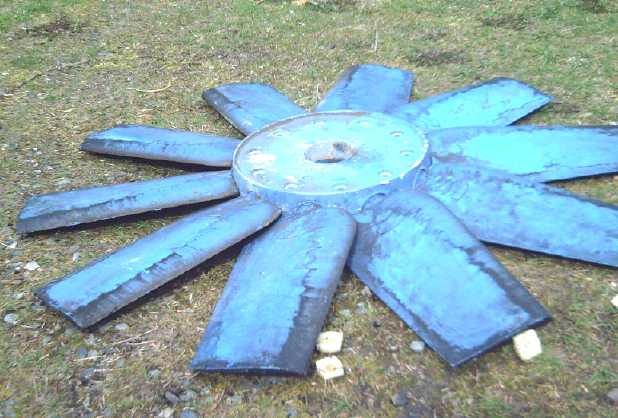 Lawrence from
Drifttech Mechanical in Masset gave me an
oily 5 gallon bucket full of plastic blades, one of two "hub" pieces
that held them all together, and a bag of bolts and bits for it. It was
a heavy duty 10 blade duct fan from an old military installation.
("Made in
England" perhaps gives an idea of the age of the unit.) He said the
other half of the hub was stuck on a motor out in the yard that no one
had managed to get off. (Actually there were two there, identical.)
Lawrence from
Drifttech Mechanical in Masset gave me an
oily 5 gallon bucket full of plastic blades, one of two "hub" pieces
that held them all together, and a bag of bolts and bits for it. It was
a heavy duty 10 blade duct fan from an old military installation.
("Made in
England" perhaps gives an idea of the age of the unit.) He said the
other half of the hub was stuck on a motor out in the yard that no one
had managed to get off. (Actually there were two there, identical.)
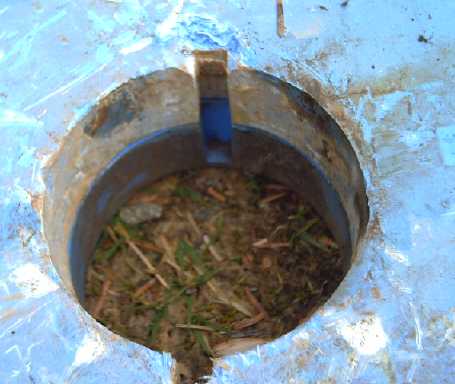 On the 9th I
returned and had a look. I asked
for a pry
bar. He was dubious I'd be able budge it. So was I, but I was there
and thought I should try. It was really rusted solid. The 7.5 HP motor
was seized. (It was also 575 volts and so not very useful to anyone
even if working.) I
tried for a while and pretty much despaired at getting the metal hub of
the plastic hub loose. But I could actually wiggle the plastic piece.
What was
holding it from sliding right off? Somewhere in all the prying I had
made a crack in it. Could I break off some
little part and pull it off over the metal piece? Sure enough,
sufficient prying and hammering broke two little bits behind the two
shaft keys and I
pulled it off.
On the 9th I
returned and had a look. I asked
for a pry
bar. He was dubious I'd be able budge it. So was I, but I was there
and thought I should try. It was really rusted solid. The 7.5 HP motor
was seized. (It was also 575 volts and so not very useful to anyone
even if working.) I
tried for a while and pretty much despaired at getting the metal hub of
the plastic hub loose. But I could actually wiggle the plastic piece.
What was
holding it from sliding right off? Somewhere in all the prying I had
made a crack in it. Could I break off some
little part and pull it off over the metal piece? Sure enough,
sufficient prying and hammering broke two little bits behind the two
shaft keys and I
pulled it off.
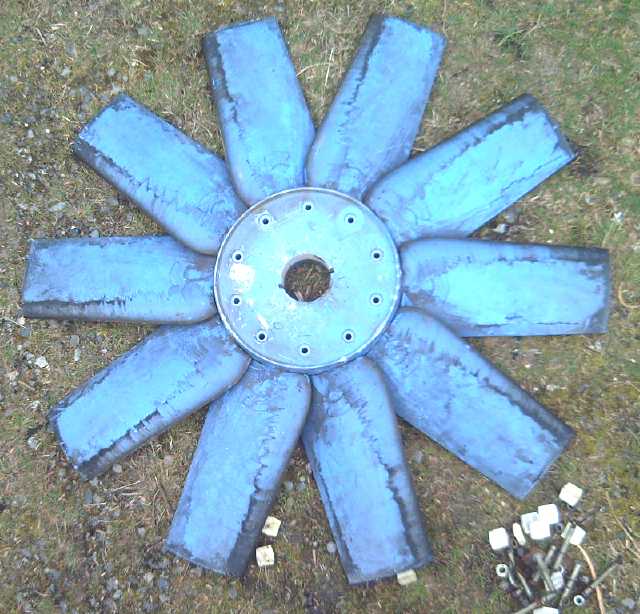 What do I want it for? I don't
know. I sort of thought for
a water turbine, but at 165mm or 38 inches diameter, it seemed pretty
big for that. Yet smaller than my cheap wind plant, so for wind power
I'd rather use that. (And anyway I was
doing the vertical axis design for either wind or water.) At first I
thought the
twist in the blades was wrong, then I realized it was only wrong for a
wind or water plant. The twist for those is mirror image to that for an
air blowing fan, which is what it was.
What do I want it for? I don't
know. I sort of thought for
a water turbine, but at 165mm or 38 inches diameter, it seemed pretty
big for that. Yet smaller than my cheap wind plant, so for wind power
I'd rather use that. (And anyway I was
doing the vertical axis design for either wind or water.) At first I
thought the
twist in the blades was wrong, then I realized it was only wrong for a
wind or water plant. The twist for those is mirror image to that for an
air blowing fan, which is what it was.
The only thing I could think it
would be ideal
for - and only if it's strong enough, which is doubtful - would be as
the fan for a ducted fan for
the full size ground effect craft. (...or maybe for a better mini
wind tunnel?) As I haven't even got the RC model
working right after all this time, I may never get around to trying to
build a full size one. Well, if I ever do, here's one fan for a
ducted fan motor! (Of course I wanted at least two, preferably four,
smaller ones - and I was hoping I could buy complete units somewhere! I
wonder if the other fan - there is a second hub-rear on another motor,
so there must have been two originally - is still kicking around unused
somewhere, free for the taking?)
Well, it (now the complete basic fan assembly) can continue to sit in a
5 gallon
bucket in my storage.
Echo Muffler Repair
Near the end of the month
the tailpipe and muffler separated on my Toyota Echo. It was a noisy
trip to Masset, which is too far to take the electric Leaf! (They keep
promising to put in a charging station there... and in Port Clements...
and in Tlell... all vaporware so far for over 4 years.) If I was on the
mainland I'd doubtless have run to a muffler shop and spent a few
hundred dollars for an installed replacement. Instead I cut off the
bolts that hung the muffler in place with the angle grinder and took it
off. It looked fine. Only the pipe, right where it went into the
muffler, had rusted through. I had a piece of exhaust pipe that proved
just right. I cut an 8 inch piece and it fit just inside the hole in
the muffler, and just inside the original pipe. I welded it into the
muffler with just enough sticking out to fit into the original pipe,
and put it all back together again. I drilled holes and put in new
bolts. I didn't even try to seal the overlapping pipes, but the car
sounded fine. It hardly took longer than driving into town and cost no
money. Yay!
Lithium Iron Phosphate Batteries
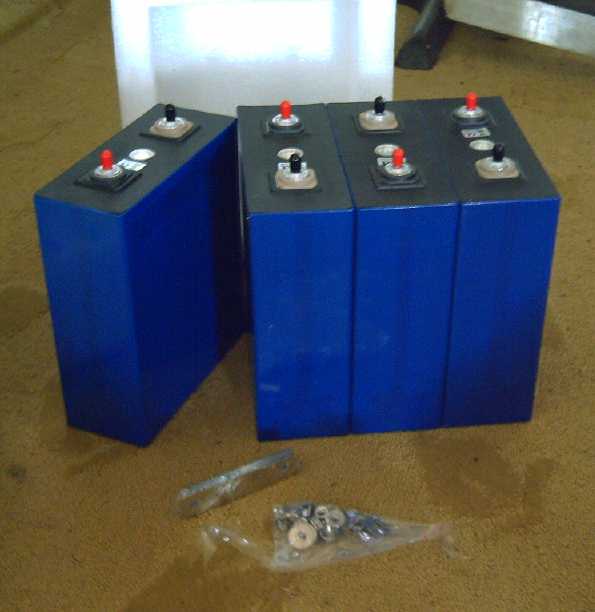 On December
23rd I ordered four 280 AH LiFePO3 cells. They arrived May 2nd. I had
inquired over a month ago about their status and was told they were on
a ship waiting off Vancouver along with hundreds of their other orders.
Big batteries cross the ocean by ship. That supply chain crisis you've
been hearing about? It's real!
On December
23rd I ordered four 280 AH LiFePO3 cells. They arrived May 2nd. I had
inquired over a month ago about their status and was told they were on
a ship waiting off Vancouver along with hundreds of their other orders.
Big batteries cross the ocean by ship. That supply chain crisis you've
been hearing about? It's real!
(Apparently the wait times are finally starting to
shrink... But only because so much of China is locked down with "zero
covid" policy - just because of an occasional case here and there - so
new products aren't being created and loaded onto ships. WHO by autumn
2020 was begging countries not to lock down to slow the spread, because
Covid wasn't that bad and it was killing economies. Seems to me to be
as futile as it is harmful to all. I'm not sure that's the sort of
reason we wanted for the shipping delays to be reduced!)
In
Passing
(Miscellaneous topics, editorial comments & opinionated rants)
Food
Shortages?
Why do I think there
are going to be global food shortages? Perhaps we should start with the
obvious: the Earth's carrying capacity is probably around 3 billion
people. With an estimated 7.8 billion, we have for 60 years been using
up resources (even the renewable resources) faster and by now far
faster than they can be replaced. We have about reached or can see the
end of accessible supplies of many things approaching. Last year a
Goldman Sachs bank report put it "We're short of everything. You name
it, we're out of it." Actions by various governments and entities have
definitely advanced the day of reckoning, but to put it simply,
population collapse is inevitable.
In various obscure or local news articles there have been
report after report of various problems and reduced production here,
there and everywhere, and various countries banning food exports
because they can see shortages coming. There have been poor crops if
not crop disasters in many regions since about early 2019 owing to
weather and in some places locusts or mice, all gradually reducing and
eliminating stockpiles globally. It seems to keep getting worse.
Millions of farmers have been bankrupted in the last few years. Bill
Gates and other non-farmers have been buying up all the farmland. Will
anyone be planting these farms? This year there are, seemingly quite
suddenly, serious global fertilizer shortages of all the main NPK
fertilizers, which will result in reduced crop yields most everywhere.
Prices have risen - double even to fivefold. Some farmers are switching
to crops needing less fertilizer, some just aren't going to bother
planting this year.
Then there are the supply chain problems. My latest info
just from the last year or so, going just by memory:
1. Canada & USA: poor wheat harvests 2021 owing to drought, early
snows.
2. USA: Reduced corn harvest owing to dericho and tornadoes across
midwest.
3. South America: poor soy, wheat harvests 2022 owing to drought &
(2021)locusts.
4. Germany (2020), Australia (2021): incredible plagues of mice eating
the crops before and during harvest.
5. Horn of Africa to Middle East & Iran (2020-2021?): Locusts
devouring the crops in the fields across vast areas.
6. Russia, Ukraine: good crops last year, no planting or no exports
this year. (Normally they account for 30% of world wheat exports &
most of the sunflower oil.)
7. Widespread reduction of cattle herds because of droughts leading to
insufficient feed to maintain them. Even calves - future cattle - are
being slaughtered prematurely. In Mexico (2021), cattle have even been
simply dropping dead of starvation and thirst. All these greatly
reduced herds can't be built up again in a year or two, and even that
would depend on having a secure food supply for them. Instead, droughts
have been getting worse.
8. Widespread slaughter of swine, chickens kept in inhumane crowded
"factory farm" conditions by the millions, trying to contain diseases.
9. California produce, nuts, fruits reduced/trees destroyed by severe
drought (esp. 2021, 2022).
10. Mild to extreme drought across Western to Central USA (&
presumably Canada) (2021, 2022).
11. India: Good wheat crop 2021 (as big as Ukraine + Russia crops but
mostly consumed within India). 2022 weather is predicted to be too hot
to grow wheat in many regions. May apply also to Bangladesh &
Pakistan.
12. China (2021): Disastrous crop season owing to massive flooding
central and south, drought and cold in the north. They bought pretty
much all the food they could find from anywhere in the world,
contributing to food price rises everywhere.
13. China (2022): Wide scale Covid lockdowns are threatening China's
whole economy. There have been widespread runs on grocery stores.
14. In USA, UK & Europe governments are paying farmers more to not
grow food or to ranch, to leave land fallow, than they could earn from
the crops. (Given the situation, this is puzzling.)
15. Major food storage and processing facilities around the world seem
to have been going up in smoke or exploding. so many that some suspect
deliberate arson/sabotage of some sort - a deliberate attack on the
world's food supply. (But who? How? Why?)
That's off the top of my head. A little research could
probably double the number of headings (and doubtless correct a few of
the above "from memory" details).
(I'm growing a few sunflowers this year and I have an oil extractor.
We'll see if that amounts to anything even for personal use! In
Victoria imported gray squirrels ate my sunflowers. We don't have those
squirrels here.)
Ukraine...
A.K.A.
USA (by Proxy) Versus Russia
As the month went on, something that became clear was that
Russia is fighting not Ukraine but the full
force of the American
military-industrial/banking/government/intelligence agencies/whatever
complex -
the Washington oligarchy - who were and are prosecuting their cunning
and corrupt profiteering plans for the region. The USA says they have
provided 35
billion dollars "aid to Ukraine" (I think that was since 2014) and in
this decade a billion here, a billion there, and still more since
February. (Oops, that's 15 billion more pledged since February 24th!
...or 3 billion dollars worth of weapons in US stockpiles. And now
Biden asks for another 33 billion!)
Ukraine plays some key roles in the American scheme:
1. With its ongoing military attacks on the Russian-speaking Donbass
republics since 2014 (not to
mention alarming talk about getting nuclear weapons and joining NATO,
and with NATO refusing to discuss or allay Russian concerns) Ukraine
provided the USA with the
sure-fire provocations to virtually force Russia to strike - which
western mass media of course said was an unprovoked outrage to
Ukrainian sovereignty and democracy in defiance of all its own
reporting in previous
years about the rise of violent neonaziism making Ukraine ungovernable,
and about the ongoing genocide in Donetsk and Lugansk. That genocide
was prodded on and on and paid for by the US. They would not let
Ukraine implement the Minsk peace protocols.
2. It provided a battlefield far from American shores which wouldn't
readily be associated with America to be seen as American aggression.
3. It provided a nation of violent and fierce warriors with hatred in
their hearts to pull the
triggers on the American weapons provided and take the casualties of
the fighting. In fact, USA pretty much created that mindset and
situation in Ukraine and among the foreign mercenaries that joined the
neonazis.
No American troops would be going home in body bags this time.
The rape of Ukraine in the interests of the American oligarchs,
especially since 2014, is exemplified by the countless millions
"earned" there by Joe and Hunter Biden. But apparently other Americans
have made fortunes there as
well, at the expense of "banana republic" Ukraine. (Who, again, has
violated Ukraine's
sovereignty?) Washington's objectives have been stated:
1. To weaken Russia militarily and economicly.
What is the justification for that aim? None has been
stated. Except for helping the
USA to defeat ISIS in Syria some years back, Russia has been pretty
much quietly minding its
own business and attending to its own economy for some decades now.
Washington just doesn't like any nation on Earth to be
able to
stand up to its will and pursue their own interests, and it enriches
its own aristocracy by shady and
lucrative deals in all those nations that cannot. And of course, the
USA created
ISIS while claiming to be fighting it as they bombed Syria to rubble,
so while they couldn't say anything without publicly admitting their
double game, the last thing they wanted was help eliminating ISIS. So
revenge is doubtless one of the oligarchy's unstated motives.
2. "Regime change in Russia" is also a stated aim of Biden. (I thought
USA "supported democracy"? That support seems to be very selective. No
point waiting for an election in Russia when Putin is so popular, is
there? Use violence instead - democracy be dammed!) In Ukraine,
Zelensky had the opposition thrown in jail. There's democracy worthy of
support!
Beyond those, the US military-industrial complex and the oligarchy are
making "a killing" - fortunes. Weapons sales are lucrative if somebody
else is taking the casualties and destruction. Of course, the American
people are the ones who
finally must foot the bills, but the Washington oligarchy cares no more
for them than for Ukrainians or Russians. (Global famine draws on
apace.)
I now have heard that Ukraine since February 2021 had been
planning to attack not only the Donbass but also Crimea. Crimea being
reunited with Russia again, I have no idea who would think
such a plan that had any basis in sanity. Did the Americans make big
promises that they would and could prevent Russia from effectively
defending it? Was it bribery? Was it blackmail? Zelensky is clearly
their puppet. From saying Ukraine had to negotiate for the sake of the
Ukrainian people he backtracked, and from peace talks progressing
favorably, suddenly Ukraine reneged on all the previously agreed
points, subtly changing them to mean something else, and like a spoiled
baby having a tantrum demanded
Donbass and Crimea again.
And just how did Biden and the US establishment "know"
that Russia was going to attack Ukraine weeks before it happened? Aside
from US "intelligence", in
the last analysis they were certain Russia wouldn't just sit by and let
the Russian speaking Donbassians be slaughtered as the shelling of
their cities by Ukraine ramped up to unprecedented levels, obviously
preliminary to an invasion of obliteration. Even aside from
humanitarian grounds, 300,000 had fled the Donbass into Russia as
refugees since 2014, and now tens of thousands more were on the move.
It looked like that would soon become more hundreds of thousands that
Russia would have to suddenly take in - perhaps even a million or more
refugees to feed and house?
More and more suspicious things have happened. The
carefully targeted attacks on Russian military and industrial centers
within Russia far behind the front lines have far more the character of
American drone strikes and the attacks on infrastructure behind Iranian
lines when the USA was displeased with Iran than acts of
unsophisticated militants in Ukraine who were "innocent" and "taken by
surprise" by the "unexpected" Russian attack. (I wouldn't even be
surprised if some
laser weapon that can start fires is being operated from a satellite in
orbit - such lasers have been developed for some time now, and many
suspicious things have happened. For example, there have been many
suspicious fires at food processing and storage facilities around the
world lately - and many suspect someone(s) of influence is trying to
damage the food
supply and distribution of the entire world. Population reduction
agenda? But I digress.) The strategic targets inside Russia were
obviously carefully selected beforehand and there will doubtless be
more of them, regardless of
how things are going on the battlefield.
And now we have anonymous US government employees
(apparently at fairly high levels) making
claims: like the one who said he had provided the targeting information
to Ukraine to shoot down a Russian military transport carrying up to
200 paratroopers who were to take Kiev airport on the first day of the
war. (zerohedge.com, April 27th: "US Intel Helped Ukraine Shoot Down a
Russian Plane Carrying Hundreds of paratroopers". But it wasn't just a
plane. We start to see that Russia had no benefit of surprise in its
"unexpected" and "unprovoked" attack. Instead, many traps were laid
beforehand that
probably explain much about the whole progress of the war and
especially the debacle at Kiev. By Early May US sources were claiming
they had provided targeting information to Ukraine on the Russian
generals who were killed in the Kiev area and for the Ukrainian(?)
missiles that sank the cruiser Moskva.
So. Ukrainians are on the battlefield. But who is behind
the
lines actually planning and pulling the triggers on all these various
drone strikes
and remote attacks? If it's
Ukrainians they're doubtless being given detailed instructions by
American agents standing behind them. Again who is fighting Russia?
I heard in 2014 that much of the Ukrainian army had
"deserted" after the Maidan insurrection/coup. Now I find this was not
exactly true: evidently about 1/3 of them joined Donetsk or Lugansk
after the massacre of Russian speaking demonstrators in Odessa by
Ukrainian speaking demonstrators.
Thus it was that the new Ukraine failed to take control of what then
became the two Donbass republics.
Before the end of the month, the secretary of the Russian
security council Nikolay Petrushev warned that the policies of Kiev
(with NATO and Washington behind them) could lead to the dissolution
of Ukraine as a state, into several states. Others have said that since
2014 Ukraine has only been held together by mortal fear of the neonazis.
It is a truism that the strongest state is one with one
people and one language. Even with deepl.com (etc.) translators, having
different languages is a barrier to the best unity. (Canada has held
together by
being quite kind to the French speaking minority and with good
tolerance and respect from all for each other, but it too has had
hurdles.)
What is the point of continuing this war for Ukraine? It
seems to me all they can do in this war is lose - lose more and more
territories, not to mention more and more vital infrastructure and
export revenue, the longer they keep
fighting. Is killing them the only way to get rid of the violent
neonazis that
have made the nation ungovernable and peace seemingly impossible? But
they are being flogged on by Washington. "To win you have to believe
that you can win." said US forces chief Lloyd Austin to Zelensky as he
promised more billions of US taxpayer dollars worth of destructive
weapons. (Hyperinflation, anyone?)
Ukraine is now claiming that Hungary wants to take part of their
territory, a region that belonged to Hungary before world war two. When
will Kiev decide to make peace? Can they even make such a decision
without the politicians being killed by the neonazis?
And if Ukraine should somehow prevail and drive Russia and
the Lugansk and Donetsk republics out of the Donbass, what then? Will
they invade Crimea and Russia itself? A nuclear armed nation with its
back to the wall is a really scary thought. And Russia is well aware
that the USA has been behind this Ukraine "proxy war" all along. A
nuclear exchange could still wipe out all human life on the planet, and
more and more people talk more and more casually about using nuclear
weapons.
An Enlightening Video (one of many appearing daily):
Russia just told truth about Ukraine and it's SCARY | Redacted with
Natali and Clayton Morris
https://www.youtube.com/watch?v=KK2PSkV1AN8&ab_channel=Redacted
Belorussian president Lukashenko stated that the if the
USA wanted, Biden could broker a peace deal and the fighting would be
ended in a week. Obviously nothing could be farther from American
thoughts than making peace.
Why do I interest myself in this war more than any of the
other inhumane and bigoted threats, aggressions, wars and genocides
going on around the planet? I guess it's because of the powerful
upheavals this one is causing in the world economy, financial system
and food supply.
Smol
Thots
* Isms: Someone in a prescient cartoon video from the 1950s warned
against "isms"
of all kinds. (seen on youtube. I don't remember the title or how to
find it.)
* But if I was to pick an "ism" for the present time, it would be
"Entrepreneurialism". Especially in the energy sector we need people
turning new ideas and technologies into
products for sale or for societal uses via public trusts. Capital is of
course required to prosecute new projects, but without new visions
capital is being hoarded and made unavailable to most anyone with ideas
by the already ultra-rich, with no benefit to society. This isn't to
say that entrepreneurialism will
always be a philosophy to be pursued and "worshiped" any more than
and other "ism". Capitalism has morphed into "crony capitalism" -
accumulation of capital for its own sake by the well-connected, and
become a
cancer in our society.
* Why is the Western mass media usually the last to understand the
background and the meaning behind what's happening in the world?
* Analyst Martin Armstrong (interviewed by Greg Hunter) points out that
Putin is essentially a moderate. When I've listened to him on youtube
I've heard intelligence, compassion and sincerity. The Duma (Russian
legislature) voted for military support to Donetsk and Lugansk and
apparently 80% of Russians agree it's necessary. They had to push him
to get him to make the "special military operation" into Ukraine that
the west blames on 'crazy Putin'. Every peaceful alternative he or
anyone could think of was tried first.
Worry instead about the people behind Putin who think he's
too soft and doesn't push hard enough for Russian
interests. If America pushes hard enough to somehow get him replaced,
the next
Russian president may be some hard line neocon. Then we will maybe
understand how good it was before.
* With the fuel scarcity the possibility of planting crops anywhere in
Ukraine except perhaps in the farthest west this spring sounds remote.
It's a good argument for going to electric CNC farming machinery... or
at least to electric farm vehicles... and maybe for having solar panels
and backup power. Hopefully crops are being planted in what are now
Russian/Donetsk/Lugansk areas well behind the fronts... but the bulk of
the men of those territories are at arms. Can Russia this year feed
itself, the Donbass and Ukraine too? And what will they eat in the
Middle East and Africa without Russian and Ukrainian wheat? India had
thought to fill the gap, but it seems the weather forecast is that it
will be too hot for growing wheat and they will probably have trouble
feeding themselves. And with the fertilizer shortages it appears crop
yields will be down most everywhere.
The American establishment blithely assumes USA can print
enough money to buy whatever food it needs to import as its own
production falls. If there is no surplus food anywhere on the planet to
be had, they are wrong.
* It seems Vincent Van Gogh cut off one of his own ears. But I never
heard why. Even for a crazy artist, that seemed pretty strange to me
- what could possibly be the motive, however bizarre or twisted? But
suddenly I came up with the too-obvious reason: he must have had
tinnitus. People have even killed themselves to end the maddening
ringing in their ears. Cutting off an ear to end it might actually be
worthwhile if it would work. But I'm pretty sure it would have done
nothing for poor Van Gogh.
* I had for about 4 years thought there were no honeybees on Haida
Gwaii, and people have said they're too hard to keep here. (Al
keeps trying valiantly at Sandspit in an especially favorable location,
but he had to get emergency new queens last summer, and he had to get
another batch
for a hive this spring.) Then last summer I saw one bee, and a couple
more before fall. They exist after all!
But in this cool, damp climate, where were they eking out
a living in the wild? It now occurs to me that the west part of this
island is steep mountains. No one lives there. The gravel logging roads
are so
steep that when I visited Renell Sound I had to shift the Toyota Echo
down into second or even first gear to climb up the hills from the
water.
Mountains have micro climates. There are probably a few select drier,
warmer valleys in rain shadows, perhaps with mountain meadow flowers
that might be
great to support bee colonies. Down here at the damp east coast would
probably be the farthest edge of their range.
There's no activity at my insulated hive yet. I'm thinking
bees probably are most likely to swarm in June or July. Hopefully by
then they'll have seen my unoccupied hive sitting there for months.
* In today's wars it's getting to be that nothing is safe whether it's
in the "war theater" or not - as exemplified by Russia's guided missile
attacks anywhere in Ukraine and the drone(?) strikes on critical
Russian facilities and a refinery late in the month. This will
obviously be more and more true into the future. Drones and accurate
hypersonic missiles and cruise missiles with more and more capability
are created and are becoming more plentiful, and owned by more nations.
Hopefully someday national leaders will be too scared to start wars.
Imagine if the invasions of Afghanistan, Iraq, Libya or Syria could
have potentially prompted heavy reprisal attacks directly on Washington
DC government and military buildings including the white house and the
pentagon. Would US leaders have so nonchalantly invaded other
countries, even half way around the world? The more the perpetrators of
violence and war can be directly targeted, the less need there should
be to involve whole nations in the fights. In fact in about 2018 Trump
had an Iranian general killed with a remote drone strike, a man who had
directed multiple strikes on US bases in Iraq. For all the indignation
of Iran following the incident, that seemed to end the attacks without
further bloodshed. (I wonder if there weren't many average Iranian
citizens who, to put it kindly, didn't miss this man at all.)
That Russia hasn't killed Zelensky is probably only due to
their not wanting to leave a power vacuum in Kiev.
ESD
(Eccentric Silliness Department)
* Some say cutting hair makes it grow faster. It's true! 1/4 inch long
hair will double its length in 2 or 3 weeks, but doubling 2 inch long
hair takes months. (They also say "all is relative!")
* Countries Quiz
1. Country named after a nut
2. The slipperiest nation
3. A country in a hurry
4. Nation ready for dinner
5. On the Christmas dinner menu for aforementioned country
6. Included in the table setting for the above
7. A little silver for the table?
8. Pike, North, South, Telephone, Power, Fence...
9. Public twice nations
10. Stinky Shoreline
11. Able to sum up numbers? (not under current leader)
Answers
(Try not to see the next one down!)
.
.
.
.
.
.
.
.
.
.
1. Brazil (This is in fact true)
.
.
==================
.
.
2. Greece
.
.
==================
.
.
3. Russia
.
.
==================
.
.
4. Hungary
.
.
==================
.
.
5. Turkey
.
.
==================
.
.
6. China
.
.
==================
.
.
7. Argentina ("Argent" is Spanish for silver. Wait, that's
French...huh? Isn't Spanish "Plata"?)
.
.
==================
.
.
8. Poland
.
.
==================
.
.
9. "Re-publics"
.
.
==================
.
.
10. Costa Rica
.
.
==================
.
.
11. Can add, uh? - Canada
.
.
* Never do today what can be put off until tomorrow. (After all,
you might die in the night, and then you'll have saved yourself the
trouble! Surely it's worth that one chance in a zillion?)
"in depth reports" for
each project are below. I hope they may be useful to anyone who wants
to get into a similar project, to glean ideas for how something
might be done, as well as things that might have been tried, or just
thought
of and not tried... and even of how not to do something - why
it didn't
work or proved impractical. Sometimes they set out inventive thoughts
almost as they occur - and are the actual organization and elaboration
in writing of those thoughts. They are thus partly a diary and are not
extensively proof-read for literary perfection, consistency,
completeness and elimination of duplications before
publication. I hope they may add to the body of wisdom for other
researchers and developers to help them find more productive paths and
avoid potential pitfalls and dead ends.
(No Reports)
Other "Green" & Electric Equipment Projects
Gardening
Tiller for Lawn Tractor and
Barley Patch
I have been wanting to plant a decent patch of grain. I
was thinking of barley this year. If nothing else, for "free" chicken
feed. (Feed is extra expensive around here.)
Seeing as I still haven't got around to making a CNC gardening machine,
I just wanted something that I could scratch grooves into the lawn
with.
Then I could sprinkle the grain seeds into the groove and "erase" them
with my foot, so the birds wouldn't eat the seeds. I wasn't going to
attempt to remove the
lawn grass, but I've seen that grains will outgrow it and rise above it
for easy harvesting. (I understand most grains don't need rich soil,
and I saw that some wheat kernels the chickens missed grew nicely last
year.)
With the little lawn tractor with its weak transmission
and easy-slip wheels, I was thinking it might manage digging just one
groove at a time without hiccups, but that that would be better than
trying to dig through heavy clumps of grass sod by hand.
Sometime last spring I got as far as two pipes attached to
the
tractor with a triangle steel plate welded on (as shown), an
arrangement suggested by a neighbor (who also supplied the materials).
I contrived to attach a "U" bracket to the back of the tractor to bolt
it on so it could pivot up and down.
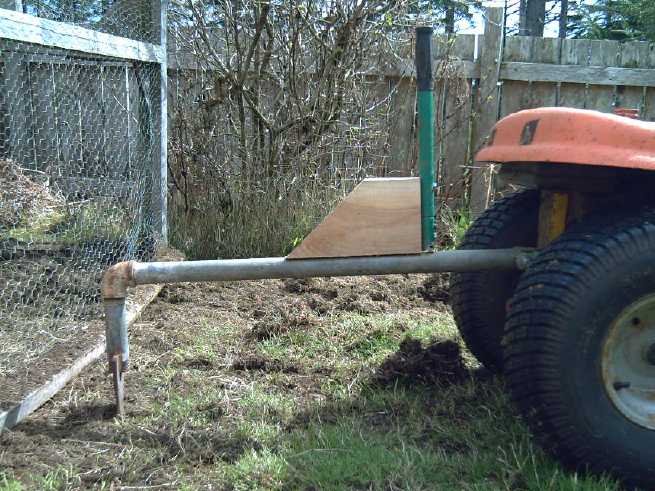 [18th-19th] I got out this
half made implement and attached it to the
tractor. It seemed to need
something... perhaps a handle so the operator could pull it up to drive
freely and maneuver, or push it down into the grass. I came up
with a real live metal handle - one that kept falling off a crappy pair
of two-handed branch loppers. Then I figured the easiest way to attach
it would be to make a block of wood and bolt it to the "arm" of the
tiller and to the handle. That seemed to work quite well fastened with
lag screws after 2 drilling holes in each pipe. (A latch to hold the
tiller "up" for convenience can come later.)
[18th-19th] I got out this
half made implement and attached it to the
tractor. It seemed to need
something... perhaps a handle so the operator could pull it up to drive
freely and maneuver, or push it down into the grass. I came up
with a real live metal handle - one that kept falling off a crappy pair
of two-handed branch loppers. Then I figured the easiest way to attach
it would be to make a block of wood and bolt it to the "arm" of the
tiller and to the handle. That seemed to work quite well fastened with
lag screws after 2 drilling holes in each pipe. (A latch to hold the
tiller "up" for convenience can come later.)
 The triangle dug into the ground
okay to start with, but
soon it would collect a clump of moss and grass roots and ride on top
of it without doing any more digging, even while I pressed it down. I
put it in a vise and bent the bottom point forward... more and more,
without curing the problem. Then I started shaping it by taking
material
off the sides. That seemed to help a bit.
The triangle dug into the ground
okay to start with, but
soon it would collect a clump of moss and grass roots and ride on top
of it without doing any more digging, even while I pressed it down. I
put it in a vise and bent the bottom point forward... more and more,
without curing the problem. Then I started shaping it by taking
material
off the sides. That seemed to help a bit.
[25th] I finally did some more shaping and scratched little furrows. I
discovered that the tractor wheels ran over the previous ones and
packed them down again. Ah! So this is (obviously) why plows are at
least the width of the tractor.
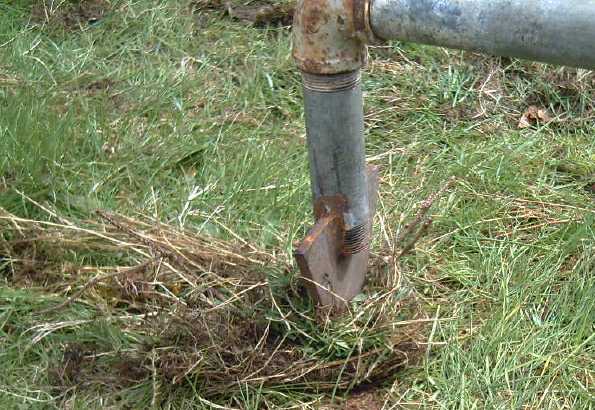
The Mini
Barley Field - the
scratches with the seeds, driven over again by the lawn tractor, are
hardly evident.
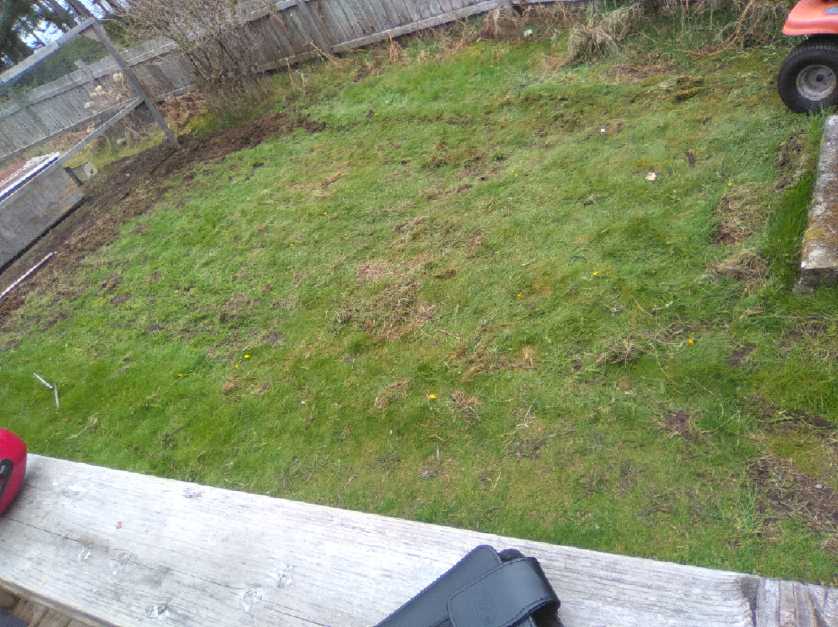 I planted some
barley. They were nothing like
straight rows. The tiller stuck out the back so far that if I turned
left it first went right, and I was continually oversteering or
steering the wrong way. [26th] In the morning I did the rest, digging
one furrow at a time and then sprinkling the seeds. The tractor wheels
then helped bury them.
I planted some
barley. They were nothing like
straight rows. The tiller stuck out the back so far that if I turned
left it first went right, and I was continually oversteering or
steering the wrong way. [26th] In the morning I did the rest, digging
one furrow at a time and then sprinkling the seeds. The tractor wheels
then helped bury them.
I was repeatedly starting, going a little way, and then
stopping. I had to stop with the tiller about 7 feet short of the end
obstacle for most of it. Next time I would prefer a much longer field
(any width), and a weight to hold down the tiller.
It occurs to me that this might also be a good way to make
a tiller implement for a CNC gardening machine. (Why, one could even
make straight, equidistant rows with that! And it wouldn't drive over
them after!0 In fact, this enthuses me -
a little - for trying to actually make the rudimentary machine.)
Spruce Roots
I dug and cut out another length of root from the old
spruce tree. I didn't find where it joined to a big piece near the
stump, and ended up cutting out the whole big piece. The root I wanted
out was hidden. It turned out to connect sort of underneath (where
shovel is).
Even with the base end finally liberated the root in
question branched in the middle under a nearly impenetrable clump of
swamp grass, which took still more time to dig out. (The other two
roots go next to the fence under more swamp grass. Maybe next year.)
Too many projects end up bigger than they look!

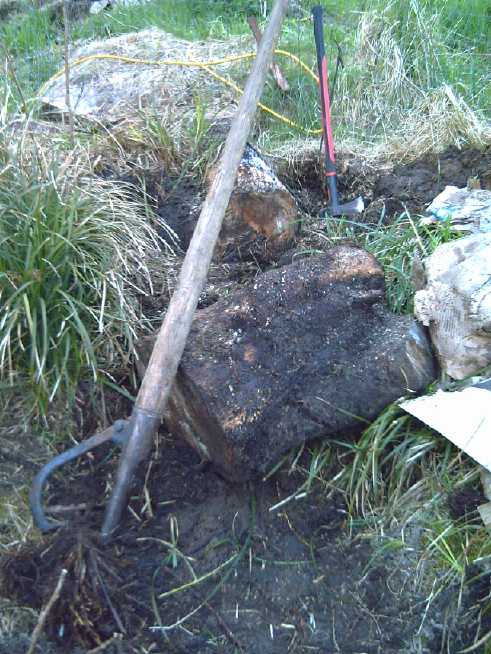
Seedlings
I got many of the seedlings I started in February and
March planted outside or in the greenhouse.
Corn
On May 1st I planted the corn seedlings in the greenhouse
- same place as last year, with some fertilizer added: lime, woodstove
ash, 4-10-10, chicken coop sweepings. And with the greenhouse pretty
well set up this time.
I watched a youtube video of hand pollinating corn for
small patches. The guy shook some corn tassels over a newspaper, then
he folded it and blew the dust onto the corn silks. Even in the video
one could see that this spread pollen dust well over the silks. Much
better than my just brushing broken off tassels on the silks. I have
high hopes for getting nice full ears of corn now, which I've rarely
had before even when gardening in Victoria!
Purchased Raspberries, Blueberries and Tomatoes
I went to a nursery and bought a couple more blueberry
plants. I planted them at the edges of the main garden where there were
already a black current and two josta berry bushes.
A lot of my own seedlings didn't grow, or grew very
slowly. It must not have been warm enough by the window. I contrasted
the 15 inch tall tomato plants at the nursery with my 2 inch ones and
bought three. I planted them in pots in the greenhouse.
Potatoes
After clearing out spruce tree roots from the expanded
main garden, I planted three 12 foot rows of potatoes in the cleared
area. They grow great here, and how many millions of people have lived
off potatoes? When potatoes were introduced the population of Ireland
grew by something like 20 million people. When the perhaps over-planted
potatoes caught a blight and wouldn't grow, just as many had to leave
or starved.
When the garden was cleared 2 years ago, the grass sods
were dumped into a big pile. I had put a few small potatoes into the
attempted garden the year before, and these randomly scattered in the
pile of grass sods had outgrown all the weeds and grass, and grown into
something like 12 Kg of potatoes, including some huge ones. The next
year there were fewer and smaller. I found out later that loose soil is
what potatoes like best.
So this year I resolved to dig it up and loosen it again,
making a larger but shorter raised pile. I used the "clam digging"
shovel and the electric mini rototiller. Every shovel seemed to bring
up another potato, and by the time I was done, even after planting the
patch again, I had 2 gallons of potatoes in a bucket.
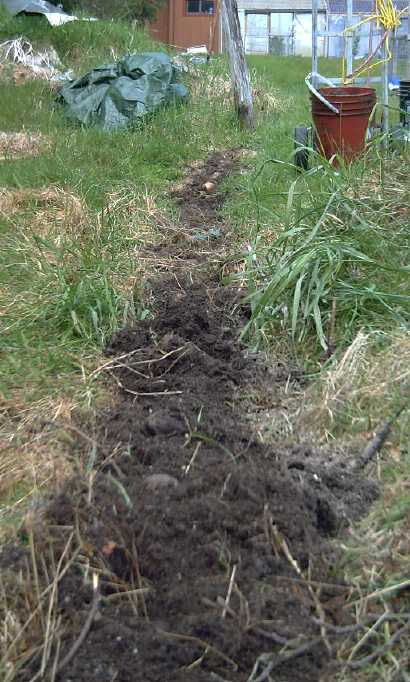
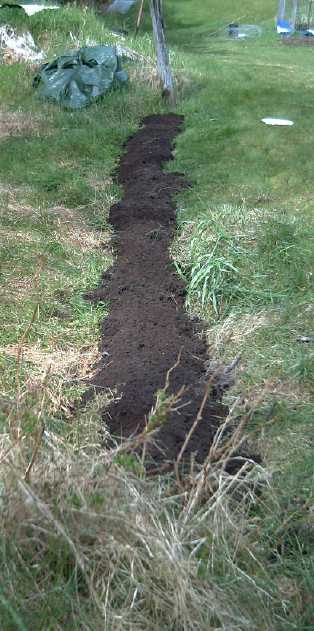 What
to do with all those potatoes? They would go bad before I ate very
many. I looked at the old garden that was here when I came but shaded
by alder trees to the south. Having so recently cut down the two
biggest and closest, I thought the front area should get enough sun to
grow potatoes if nothing else. I planted two rows about 25 feet long by
disturbing the thick grass sod a little, putting on some fertilizer,
then laying down the potatoes in a line 8 or 10 inches apart. (left
image. Some of the potatoes are dark color - purple skins and flesh,
hence are less visible than the white ones.) Then I dug up and brought
in some other soil to cover it all, raising the whole level by 5 or 6
inches - 6 inches being said to be the best depth to plant potatoes at.
If potatoes start showing around the edges I may need to "hill them" -
add soil to cover them.
What
to do with all those potatoes? They would go bad before I ate very
many. I looked at the old garden that was here when I came but shaded
by alder trees to the south. Having so recently cut down the two
biggest and closest, I thought the front area should get enough sun to
grow potatoes if nothing else. I planted two rows about 25 feet long by
disturbing the thick grass sod a little, putting on some fertilizer,
then laying down the potatoes in a line 8 or 10 inches apart. (left
image. Some of the potatoes are dark color - purple skins and flesh,
hence are less visible than the white ones.) Then I dug up and brought
in some other soil to cover it all, raising the whole level by 5 or 6
inches - 6 inches being said to be the best depth to plant potatoes at.
If potatoes start showing around the edges I may need to "hill them" -
add soil to cover them.
Seeing this my neighbor said he had an old, working
rototiller in Lac la Hache that he would bring up next time they were
down there and up again, and sell to me for "an exorbitant price". It
could be a fabulous implement for trying to dig up grass sods to make
more garden - including for planting grains, which I'd like to
considerably expand on at least to get free chicken feed. (~30$/bag
here last I bought some. It was 15$ in Victoria in 2017.)
I still had some potatoes in the bucket and found some
more with more digging, too, so I'm planting a third row.
English Walnut Tree!
[9th] I saw a store had a newly
arrived selection of spring
plants. I bought an "English Walnut" tree, 6 feet tall in a big pot.
(nearly 150$ - egads!) The
owner said "Good choice - that's the last one." Wow, already? She said
she had
been pleased to be able to get them in. We're surely too far north for
Pecan or even "Hardy Almond". I thought "English" walnuts sounded like
a good choice since northern England is as far north as Haida Gwaii.
But later I looked it up and England is actually at the northern end of
their range. The tag said "Juglans Regia manregion". Looking that up,
the "manregian" is a specific seed strain bred in northern China that
is one zone more cold hardy than typical English walnuts. Yay! (This
store owner knows what she's doing with plants!) If these walnuts will
thrive here, they would certainly be a good nut to have. I planted it
on the north side of the house because if it grows well it will make a
lot of shade. It can shade the south edge of my neighbor's huge field
instead of my yard and solar panels! I was told they're self fertile,
but info on line said having two varieties to cross polinate gives
better yields. (But if only one is hardy enough for around here? Ah...
"Plant with Carpathian [also "more cold tolerant than others"] for
bigger crops". Later I also found cold hardy "Cascade".) This inspires
me to try to get another one delivered up here.
A friend said I should grow walnuts from seed. (especially
if I could sell them for
that sort of price!) A walnut grove would be cool! I guess I'll have to
wait a few(?) years and see if my new tree(s?) starts producing walnuts
to grow some more. (It had better do better than all the fruit trees in
that row have so far!)
Plastic Recycling 2.0
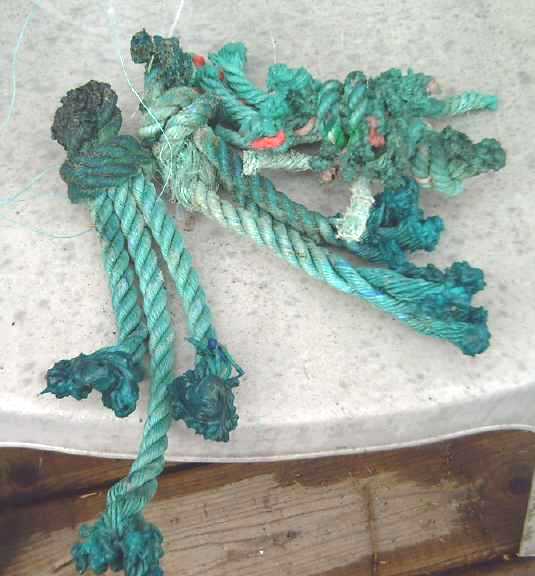 This picture got missed last
month. I tried "pre-melting" some ropes to shrink them down, just in a
pan in the oven during a molding. I took them out well before the mold
was done. But the ends melted into blobs without much seeming to happen
to the rest of the rope, so I gave it up.
This picture got missed last
month. I tried "pre-melting" some ropes to shrink them down, just in a
pan in the oven during a molding. I took them out well before the mold
was done. But the ends melted into blobs without much seeming to happen
to the rest of the rope, so I gave it up.
Adjusting the Square Box Mold
[6th] I [finally] got a chance to
look at the square box mold for making 17 x 21 inch sheets. The springs
and coathanger wires weren't working well. I wasn't
sure the angle alume edges were thick enough to put a bolt/machine
screw into the end of. What about just pins? I took a 1/16 inch drill
and drilled a hole. I put in a 1 inch small finishing nail. It seemed
to hold that corner together.
Then I did some filing and hammer adjustments and got the
"too wide" end gap pretty small, then the other 3 pins, one in each
corner.
When I dropped the top/lid into the box, instead of just
falling in, it went slowly as air whooshed out all around it. That has
to be pretty decently small gaps. I was sure that the pins would hold
it much better than the springs and coat hanger wires.
[8th] I took a trip to Coastal Propane in Masset in my Toyota Echo with
the giant box utility trailer (stripped down tent trailer) and picked
up two "expired" 85 gallon propane tanks (free!) to get the steel plate
from them. I assumed I could cut all the pieces I could possibly want
from the middle section with a zip disk in the angle grinder, and then
(I hoped) bend the shallow curve flat without denting it all up. Steve
described the sides as 5 or 6 mm thick. That sounded just right. They
haven't held propane in a couple of years, but he said to stand them
upside down for a day or two to let any propane still in them come out
the fitting holes. Propane is heavier than air. If there was any
left, it could be very dangerous - could burn violently or explode when
I made a spark. I'm leaving them upside down until I go to use them or
at least for a few weeks.
I had thought of the idea when looking at small propane
tanks, but I figured their side walls were probably too thin. I was
sure that the
big diameter tanks would have to have thicker walls to hold the
pressure.
[11th] Inside my lately rather hectic activities (plant food, plant
food!) I measured out 1400 grams of PP white & black rope, sprayed
the mold with silicone lube and filled it. It was much easier to handle
with the corner pins than with the previous coat hanger wires and
springs to hold it together. I cut the last piece of grader blade in
two to make 12 and 13 pound weights. I put the four big pieces - 45
pounds - on top of the box. I set the timer for 80 minutes, plugged in
the oven and propped a 2 by 6 against the door to keep it shut. (Then
went off to dig/saw tree roots out of the garden.)
After the time expired the temperature on the top surface
of the mold was only 195-220°C. I set the timer for 15 more minutes
(total 95 - over an hour and a half!) and went back to the root. Then I
unplugged the oven (230-250°) and set the timer for another half
hour for the plastic to finish flowing (hopefully) and start to cool
before opening the door. and went back to the root, which had another
big branch, unseen, going down. After the time lapsed the temperature
was down to 195-215°. I opened the door and left it yet another 30
minutes. By this time it was heading for dark, but I pried the big
junction section of the root free with the peevee, leaving three
smaller sections of root that could be dug out separately. (Tomorrow I
can attack the long branch going into an area I want to clean up and
plant.)
It was over 3 hours
getting this together. I got something else accomplished while it was
in process, but I couldn't fully concentrate on it. I couldn't forget
that it was going on and that I had to return at the right times to
continue the process. Indeed, forgetting about it with the oven on
might cause a fire, and I did. It was smelling hot plastic when I went
near the house that reminded me, just before it was time to check it.
Trying to fit everything in with laundry, meals and often trips into
town, perhaps one can see why I have done so few pieces in the last few
weeks rather than firing up the oven every day.
Late in the evening when it was cold, I went to take the
piece out of the mold. Three corner pins came out okay, but one broke
off. I got the sides off and was pleased to note that that mold had
filled all the way around. There were no missing corners or gaps along
the edge.
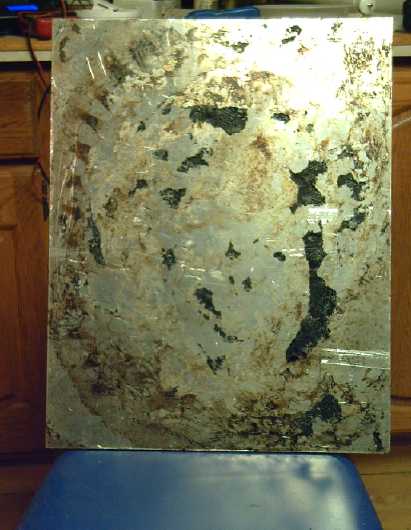 But then
getting the plastic to separate from the top and bottom plates was
horribly difficult - far worse than any other piece ever before. In
fact the surface was badly pitted, especially on the bottom side,
because some of the PP adhered to the alume instead to itself. I had
sprayed the mold with silicone lube. I used two chisels and a hammer
and spent quite a while pounding and twisting to get each side loose,
bit by bit. The black rope seemed to have stuck to the alume more than
the white one. In fact, the black rope was exactly what was
stuck to the mold - not the white. Next I had to scrape all the bits of
PP off the pieces of the mold before it could be used again. And there
were marks from the chisels. I should polish the faces of the mold, but
this was almost unbearable and I wasn't looking forward to a repeat. I
have to find some better mold release compound.
But then
getting the plastic to separate from the top and bottom plates was
horribly difficult - far worse than any other piece ever before. In
fact the surface was badly pitted, especially on the bottom side,
because some of the PP adhered to the alume instead to itself. I had
sprayed the mold with silicone lube. I used two chisels and a hammer
and spent quite a while pounding and twisting to get each side loose,
bit by bit. The black rope seemed to have stuck to the alume more than
the white one. In fact, the black rope was exactly what was
stuck to the mold - not the white. Next I had to scrape all the bits of
PP off the pieces of the mold before it could be used again. And there
were marks from the chisels. I should polish the faces of the mold, but
this was almost unbearable and I wasn't looking forward to a repeat. I
have to find some better mold release compound.
Other than the sticking and
smallish bubbles, it was pretty close to being a perfect piece.
Finally, sufficient oven heat and time, and sufficient weight on top,
seemed to have done the trick. It was thicker than the stop screws. One
whole end was in fact 1/2 inch thick - 13 mm. The other two corners
were 11 and 9 mm. This says that with everything working well (no
serious warping of the outer plates, not much lost around the edges)
1400 grams was too much PP for the 6 mm screw protrusion thickness. It
didn't feel at all heavy for its size, but maybe I'll try 1000 grams
next time. And use longer screws to get uniform thickness if I want
another thick piece.

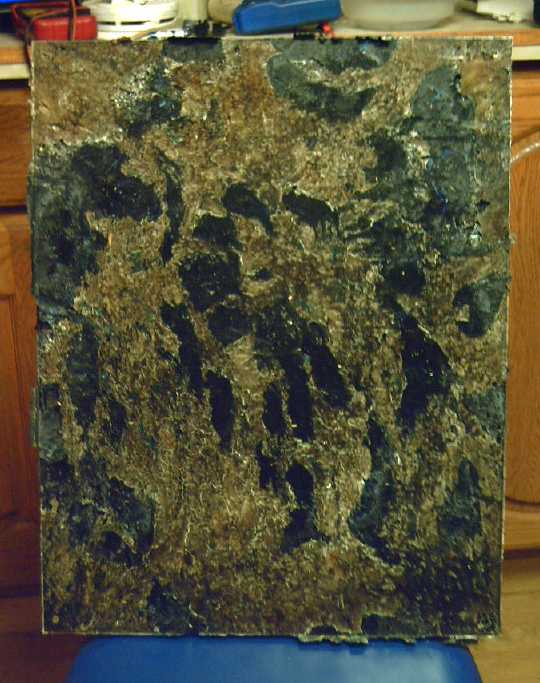 The two faces of a fairly thick
slab of PP.
The two faces of a fairly thick
slab of PP.
Many of the edges of the black rope areas are rough because they stuck
to the mold surface.
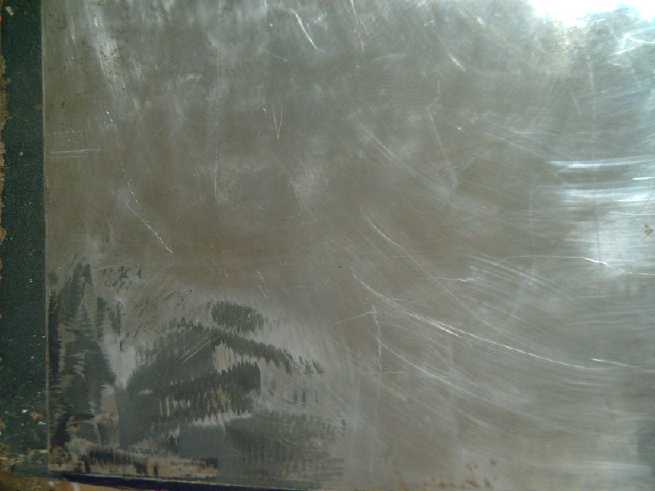 [14th] I had
thought that polishing the alume mold surfaces
would make them a good deal more slippery so the plastic would have
less tendency to stick. I had done that with the windplant blades mold
by holding them up to the drill press on highest speed with a polishing
wheel in the chuck (and have had little trouble with plastic sticking
to that mold), but larger mold pieces were too awkward for that.
Handheld drills turned too slowly to polish. Hand polishing without
power seemed absurd. Metal polishing (to my understanding) actually
works by melting molecules off the surface and redepositing them close
by - it needs considerable friction heat to work well. I talked to
Steve and he mentioned using an angle grinder. Of course! There was a
tool that had the RPM to run a metal polishing wheel and actually polish!
I
bought
some pieces and some polishing compound at the auto parts
store, but they didn't have a buffing wheel for an angle grinder. The
next day I went on line and ordered a few.
[14th] I had
thought that polishing the alume mold surfaces
would make them a good deal more slippery so the plastic would have
less tendency to stick. I had done that with the windplant blades mold
by holding them up to the drill press on highest speed with a polishing
wheel in the chuck (and have had little trouble with plastic sticking
to that mold), but larger mold pieces were too awkward for that.
Handheld drills turned too slowly to polish. Hand polishing without
power seemed absurd. Metal polishing (to my understanding) actually
works by melting molecules off the surface and redepositing them close
by - it needs considerable friction heat to work well. I talked to
Steve and he mentioned using an angle grinder. Of course! There was a
tool that had the RPM to run a metal polishing wheel and actually polish!
I
bought
some pieces and some polishing compound at the auto parts
store, but they didn't have a buffing wheel for an angle grinder. The
next day I went on line and ordered a few.
Polishing the Mold
[21st] I was too impatient to wait for the polishing disks. I had
bought what was available locally on the 14th, a rubber sandpaper base
disk, and some metal polish. I cut a coupling nut that almost fit in
half, filed down the end to a taper, and managed to pound it into the
center. The nut fit on the angle grinder. (Why it didn't come with a
nut I don't know. There wasn't much it would fit onto without one.) It
was too tall and fit outside the guard on the grinder.
I dabbed some polish onto the top face of the big
rectangle mold and spun the grinder on it. Aside from getting the
polish all over my sweater in a line at the table height (owing to no
guard) and leaving a black smear on the metal, this seemed to do some
polishing. There seemed to be too much black to be from the rubber
wheel, so it was probably the bits of black plastic stuck to the mold
surface, melted by the polishing and smeared around. Spinning the
grinder didn't seem to get rid of it, but polishing by hand with a
cloth rubbed it off. It was nothing like the simple, easy, fast job I
had hoped for, but it was cleaning and smoothing the surface. But it
didn't take out even the slightest of marks, mostly made by having to
chisel the previous piece out of the mold. I took some #600 sandpaper
to some of the gouges, which did no more than eliminate the raised
edges. I didn't have any finer, and the polish didn't take out the #600
sanding marks.
[23rd] I managed to find time to finish the polishing as best I could
without 1200 sandpaper and a proper buffing/polishing disk, and I cut
some various rope and weighed out 897 grams - 900 by any other name. I
sprayed the mold with a new bottle of silicone lube.
Later I went to Masset and found #1200 sandpaper and a
polishing pad. Still later I noticed a package of angle grinder
attachments I had bought in Victoria before I moved, and never opened.
I discovered it had all the sanding, buffing and polishing attachments
I had worked so hard to find!
Big Rectangles #5, #6
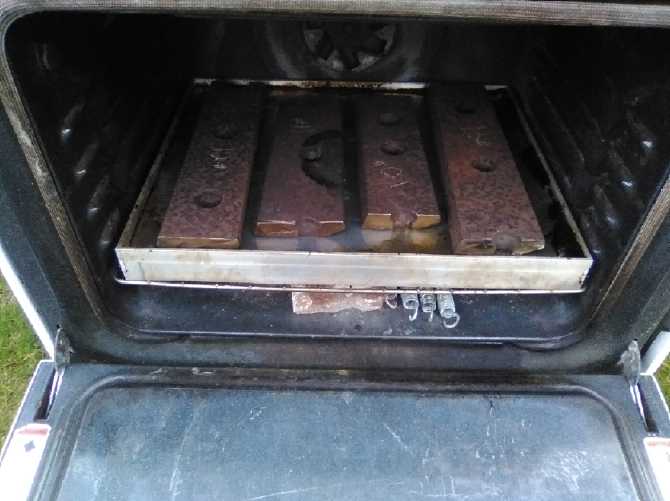 [24th] The
next morning I loaded it in and put it in the oven with the
45 pounds of weights on top, heating for 90 minutes. Temperature
readings across the plate were then 230 to 240, with just one corner
saying 258°. But there there seemed to be bubbling plastic coming
up the edge. I turned the oven off and left it to flow and spread
around for another 30 minutes with the door closed, then another 15 or
20 with the door open.
[24th] The
next morning I loaded it in and put it in the oven with the
45 pounds of weights on top, heating for 90 minutes. Temperature
readings across the plate were then 230 to 240, with just one corner
saying 258°. But there there seemed to be bubbling plastic coming
up the edge. I turned the oven off and left it to flow and spread
around for another 30 minutes with the door closed, then another 15 or
20 with the door open.
When I pulled it out, there was a fair amount bubbled up
around the edges except in one corner. I was afraid it would be another
missing corner.

 The two faces of a nice, fairly
thin plate of
PP plastic.
The two faces of a nice, fairly
thin plate of
PP plastic.
(Trimmed & corner heat-glued back on later)
When I went to get it out of the mold, I turned it upside
down and stepped on the bottom plate. The faces dropped out of the
outside frame. Then the bottom plate nearly fell off by itself. The top
plate took just a bit of prying. What a difference the polishing seemed
to have
made! (Of course I hadn't used any more of that black rope, but it was
the easiest opening yet of any flat piece.)
The piece was down to the depth setting screws on one end,
and even thinner along one edge owing to the warping of the plates. But
the other end was still 10mm thick. So 900 grams was still a little too
much plastic. Mostly the surface was much smoother than the previous
piece, but there was one considerable void in the thin area.
All the corners were filled. However, one corner had
broken off (the thickest one!), apparently held from shrinking inward
by the considerable excess PP oozed out around the edges. That was
still like jelly when I took the mold out of the oven, and I had
roughly scraped much of it off with the Robertson screwdriver. But I
suspect I'd have done better to scrape it out going right into the
crack with a chisel point or an awl. Still better would be a very close
fitting mold with only the tiniest gaps around the edges!
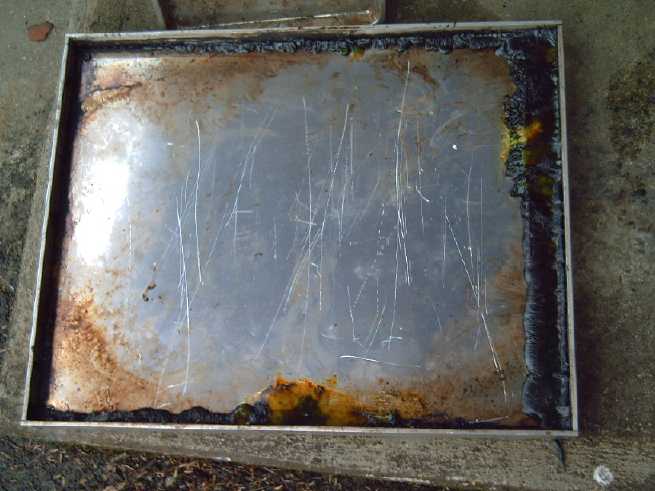 Since it was
now much easier (without plastic sticking
hard to the mold), late in the afternoon I decided to try again, this
time with 800 grams. I used some cut pieces of PP from previous
moldings as well as some fresh rope. Everything else was the same
except I decided to try without the silicone spray, thinking the polish
on the metal seemed to be doing a great job.
Since it was
now much easier (without plastic sticking
hard to the mold), late in the afternoon I decided to try again, this
time with 800 grams. I used some cut pieces of PP from previous
moldings as well as some fresh rope. Everything else was the same
except I decided to try without the silicone spray, thinking the polish
on the metal seemed to be doing a great job.
The temperature seemed a little higher - 250-260°. In
fact there seemed to be quite a bit of smoke and the plastic was
bubbling. A lot had oozed out one end. Well, the oven was already a bit
warm when it started, and it was a bit less PP to heat up. Maybe it was
warmer outside,
too? But I was surprised how hot it seemed to be. I've seen higher
readings on the meter that didn't seem this hot.
 The piece was
a disaster! It stuck to the mold
like glue,
and when I finally chiseled it off, it came off in chunks. It seemed
brittle. Inside the PP was full of bubbles - it wasn't solid except at
the surfaces, which stuck to the alume plates. So: I conclude that the
plastic sticks to the mold if it's too hot. There's some
temperature
where it will flow, but you don't want it hotter than "enough". Finally
I realized that the plastic must have been boiling. That explains the
'smoke', and why it was full of bubbles and so much came out the narrow
edge cracks.
The piece was
a disaster! It stuck to the mold
like glue,
and when I finally chiseled it off, it came off in chunks. It seemed
brittle. Inside the PP was full of bubbles - it wasn't solid except at
the surfaces, which stuck to the alume plates. So: I conclude that the
plastic sticks to the mold if it's too hot. There's some
temperature
where it will flow, but you don't want it hotter than "enough". Finally
I realized that the plastic must have been boiling. That explains the
'smoke', and why it was full of bubbles and so much came out the narrow
edge cracks.
The shape and color of a considerable yellow and green
chunk reminded someone of Ukraine. Well, the whole thing certainly
looked like it had gone through a war!
My next conclusion was that
I can't rely on timing to raise
the oven to a specific temperature. It needs a temperature control.
Well gosh, I even have a couple! I bought them a year or so ago for a
plastic injector, which I still haven't connected to. With a
temperature control and a timer, plus making the molds so the plastic
can shrink without having to undo screws, the whole process could be
automated. Once it's in the oven, I could leave it for any length of
time and just pull the piece from the cold mold later. That would make
"production" to sell rather than occasional "one offs" for prototyping
much more practical.
With the success of one piece, and with adding a
temperature control to the oven, I can imagine making thick pieces with
longer depth-setting bolts and more PP, and using them for garden path
pavers. For now I'll concentrate on thinner pieces to make sides and
vanes for the "wind wall".
But I'm dreaming now of making bigger and fancier steel
molds to make cool parts (especially big thin pieces but with thick
edge "frames" for screwing pieces together variously), and the big,
long oven to cast them in! Maybe to use instead of plywood for some
purposes (including garden edging, raised garden bed sides and wind
wall frames).
Maybe I should just make those and be done with the
regular oven and the alume molds? The main thing holding me back is how
am I going to insulate the steel box I got to use for an oven? maybe I
should get some pieces of sheet metal from the refuse station? Washing
machines, ovens... say, why don't I start with my own oven? Disassemble
it and use the elements and face pieces? (Will I still want it for
molding smaller parts once I have the new one? Do I want to disassemble
it before I have the new one running? Hmm...)
Time for something of a restart, now knowing more and
adjusting equipment and processes?
 Near the start
of May I got a freezer with a metal inside skin (instead of plastic)
from the refuse station. I cut it down shorter and took out the
compressor. I think it should make a good oven, and will hold molds up
to 22 by 56 inches. Huge! Just what I wanted!
Near the start
of May I got a freezer with a metal inside skin (instead of plastic)
from the refuse station. I cut it down shorter and took out the
compressor. I think it should make a good oven, and will hold molds up
to 22 by 56 inches. Huge! Just what I wanted!
The lid is rather mangled. I'll have to either find
another one the same size or else do a lot of banging to make it
nominally straight again.
Joining PP Pieces
[29th] The second last piece had been excellent except for the corner
that had
broken off. What to do? I decided to try melting it back on with a hot
air gun. To my surprise it worked well. "High" was fast, and even on
"low" the plastic melted and joined, albeit slowly. I then conceived
that this could be a great way to attach many and various pieces...
never mind laboriously screwing or bolting them together, shaping and
drilling pieces of metal for joiners! Just "weld" them together with
hot air! Things are looking up!
With some pressure, I broke it off. It wasn't as strong as
the solid sheet. I tried again and it was better. Another "art" needing
practice more than a science!
I went to Masset this day and finally found the one rotary
buffing/polishing pad available on the whole island at the last
hardware store I tried. (it says "for angle grinder", too!) Yay, I can
properly polish the alume mold faces!
Electricity
Storage
(Batteries)
[No Reports]
Electricity
Generation
My Solar Power System
Not So Great Grid Ties? (Seemed to work okay later - don't work
them too hard!)
On the 15th in bright sunshine from a clear sky (rare) I
saw the output to the grid at the (unfinished) cabin from the four 305W
solar panels, two on each inverter, was about 700 watts. I turned off
the "1000W" (top) inverter and it dropped to about 320 watts. I turned
it back on and unplugged the "700W" (lower) one. Power returned to 380
watts, then hit 400. I plugged the other back in and for a short time
was getting 800 watts. But next time I looked it was down to about 700
again.
I checked the other 700W unit at the house and found that
it wouldn't put out more than about 360 watts, even when more solar
panels were switched onto it. It seemed that with no cooling fans, they
were limiting themselves to hardly half their rated power to prevent
overheating. Considering how cold the air was, that was rather
disappointing.
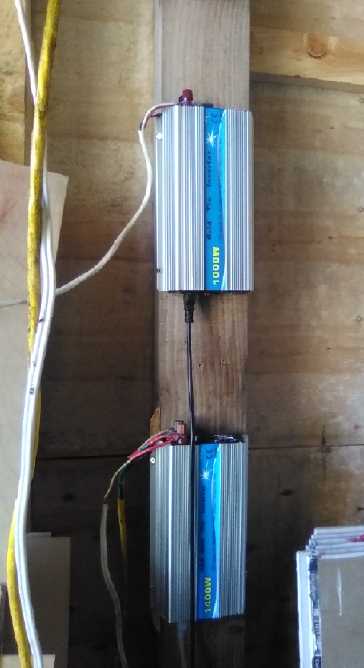 I
took the new "1400W" grid tie and put it in in place of
the "700W". After that the output was 815W. But I couldn't see
"wasting" two best trid ties on the cabin. I decided to try the 1000W
one with 3 solar panels on it and the 700W one with just one. That
started off with 760 watts: 560 and 200. That didn't seem like too big
a hit, but as the "700W" one warmed up, it suddenly cut out, and only
came back up until there was 715 watts - only 155 from it! And 100
watts down from the two best inverters. So with 400W input from the
panels it only put out 300-320, but with just 200W in, it lost 45W
anyway!
I
took the new "1400W" grid tie and put it in in place of
the "700W". After that the output was 815W. But I couldn't see
"wasting" two best trid ties on the cabin. I decided to try the 1000W
one with 3 solar panels on it and the 700W one with just one. That
started off with 760 watts: 560 and 200. That didn't seem like too big
a hit, but as the "700W" one warmed up, it suddenly cut out, and only
came back up until there was 715 watts - only 155 from it! And 100
watts down from the two best inverters. So with 400W input from the
panels it only put out 300-320, but with just 200W in, it lost 45W
anyway!
I decided to just use the "1400W" unit alone for the
cabin. That put out 735 watts. I decided that would be good enough. (On
later days I found it doing up to 800W in good sun.)
I knew that I was "overdriving" some of the grid ties, and
also that none of them put out their whole rated output. I had figured
that in our usual cloudy weather, they weren't usually going to be
overdriven from whatever the panels managed to put out. But now it
"bugged" me that even after having split the four panels onto two
inverters at the cabin, the output was still no higher. 3/4 of the
nameplate rating ("1220 watts"), 915 watts, would be typical of panels
in direct sun with panels aimed straight at the sun. 800 watts was
probably most of what the panels had available today regardless of
inverters. 700 was a 12.5% loss. I don't think I'd buy any more of
those black "700W" grid ties after all. The more common "1000W" ones
(Y-Solar or Y & H Solar) were better as well as higher rated. The
one advantage of the "700W" ones is that they take seconds instead of
minutes to come back to their full output when a cloud dims the sun.
Obviously the grid ties at
the house were transferring
even less of the available solar panel power. I replaced the "700W" one
in the house system with the "1000W" one I'd removed from the cabin.
Now I was using three 1000W grid tie interters in the house system, and
none of the apparently quite lossy "700W" ones anywhere. (Great - three
underperformers I don't want are now left over, and no other spares for
expansion!
Well, it looks like basing judgments on just one set of
readings on one day isn't necessarily a good idea: later two of them
ran three new panels quite well, making as much power as could be
expected - see next.
For some other actual readings of the decreasing
efficiency of
the 1000W grid ties with increasing load, see TE News 132.
Later I ordered - and received - two more of the new 1400W
grid ties.
Three New Solar Panels: On Carport Roof
On various times of having to go on the roof, I had
noticed that the north end of the north end garage seemed to have a
better view to the south than anywhere else. I wasn't sure about
mounting solar panels to face south on its east slope. Then I made the
carport off of that, with a shallow (7°) north slope. I had thought
about putting 2 or 3 solar panels up there.
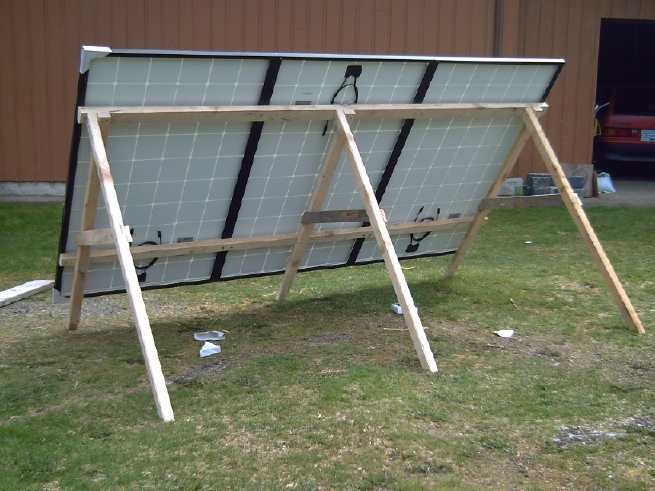 [27th] Having ripped a
couple of 2 by 6s into 2 by 3s with this in mind the
previous week, I finally got ambitious about it and made a big "A"
frame of 2 by 3s to hold the three panels. I decided to set the panels
sloped 45° facing south for best all season performance. At summer
solstice with the sun at 30° to the south, only 3% of the sunlight
at noon is lost (45-30 = 15° off of straight on, cosine 15° =
.966), while at winter solstice with the sun just 14° above the
horizon at noon (45-14 = 31° off, cosine 31° = .857), 86% is
still
captured. In the better 6 months (without troubling to figure out all
the trig) the angle is probably mostly over 99% capture at noon.
(That's as opposed to
the house
roof at 18°, which at the angles of December misses almost 50% -
and
doubtless more owing to reflection off the glass.)
[27th] Having ripped a
couple of 2 by 6s into 2 by 3s with this in mind the
previous week, I finally got ambitious about it and made a big "A"
frame of 2 by 3s to hold the three panels. I decided to set the panels
sloped 45° facing south for best all season performance. At summer
solstice with the sun at 30° to the south, only 3% of the sunlight
at noon is lost (45-30 = 15° off of straight on, cosine 15° =
.966), while at winter solstice with the sun just 14° above the
horizon at noon (45-14 = 31° off, cosine 31° = .857), 86% is
still
captured. In the better 6 months (without troubling to figure out all
the trig) the angle is probably mostly over 99% capture at noon.
(That's as opposed to
the house
roof at 18°, which at the angles of December misses almost 50% -
and
doubtless more owing to reflection off the glass.)
Of course in making it I had to figure the frame angles
and piece lengths to account for
the 7° north slope of the carport roof.
[28th] I used 3 to 1 solar panel ("MC4")
combiner connectors and ran a
couple of pre-made MC4 cables down into the carport below, by the house
wall. Having no other spares (two 1400W on order) I screwed one of the
small 700 watt grid tie inverters with no cooling fan to the wall,
connected the panels, and ran an extension cord with a power meter to
an outside wall socket. It made 600 watts for a time, got almost too
hot to touch (let alone hold), and gradually reduced itself to about
400 watts. I had more of the wires and two more of these inverters so I
went back on the roof and split it into 2 panels plus 1 with a separate
connection. I got out the second 700W unit and a power bar (to plug
them both into), screwed it on the wall and plugged everything in. This
time it started out at 690 watts - which is said to be about the
maximum one can expect from three 305 watt panels in full sunshine.
(3/4 of rated power is said to be about the max in real world
conditions: 686.25 W.) That's better than most of my system with the
too-light panel wires and the panels mounted flat on the 18° sloped
roofs. The inverter with two panels got pretty hot again, but the one
with just one was hardly warm. It seems with all the grid ties the more
lightly loaded it is, the higher the efficiency.
Up there, it's still sunny!
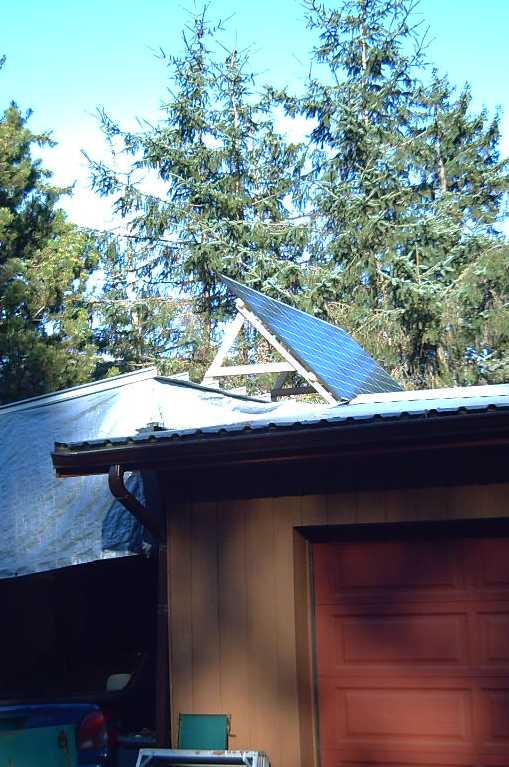 It was
obliging of the sun to shine clear with no clouds
or haze
while I was wiring it and checking it out. Not long after there was
light haze or jet trails and it dropped to 600 watts. At 6:30 PDT
(~4:42 actual solar time) the sun was well behind the row of trees to
the west and the ground was mostly in shade. The cabin was making 40
watts and the house 120, but the new panels up above the carport roof
were still in
sunlight, still making 340 watts for maybe an extra 1/2 hour.
It was
obliging of the sun to shine clear with no clouds
or haze
while I was wiring it and checking it out. Not long after there was
light haze or jet trails and it dropped to 600 watts. At 6:30 PDT
(~4:42 actual solar time) the sun was well behind the row of trees to
the west and the ground was mostly in shade. The cabin was making 40
watts and the house 120, but the new panels up above the carport roof
were still in
sunlight, still making 340 watts for maybe an extra 1/2 hour.
Well, as they say "Location is everything."
Daily/Monthly/Yearly Log of Solar
Power Generated [and grid power consumed]
(All times are in PST: clock 48 minutes ahead of sun, not PDT which
is an hour and 48 minutes ahead. (DC) battery system power output
readings are reset to zero
daily (often just for LED lights, occasionally used with other loads:
Electric car, inverters in power outages or other 36V loads), while the
grid tied readings are cumulative.)
Daily Figures
Solar: House, Trailer, (.DC@house) => total KWH [grid power
meter reading(s)@time] Sky conditions
Km = electric car drove distance, then car was charged.
March
31st 2671.39, 30.34, .00 => 8.39 [94831@19:30]
April
01st 2679.02, 34.79, .00 => 12.08 [85Km; 94876@19:30]
2nd 2681.12, 36.12, .43 => 3.76 [55km;
94909@19:30]
rain, wind, even flakes of sleet in evening.
03rd 2689.83, 41.51, .00 => 14.10 [94939@22:00] Drizzle AM, then
sunny PM.
04th 2694.28, 43.91, .00 => 6.85 [94963@20:00]
05th 2700.08, 47.82, .25 => 9.96 [94991@20:00]
06th 2701.96, 48.74, .00 => 2.80 [55Km; 95039@19:30] Howling
wind and rain
07th 2706.82, 51.37, .00 => 7.49 [95070@19:30] Nicer
than yeterday, anyway. Planted 3rd row of potatos.
08th 2714.56, 56.37, .08 => 12.82 [95099@20:00] Apparently nicer
here than it was in Masset!
09th 2720.52, 60.23, .37 => 10.19 [55Km; 95130@19:30] Frost, sun,
hail, sun, hail, sun, hail, sun, snow, sun. hi ~+4°
10th 2730.66, 66.80, .00 => 16.71 [70Km; 95171@20:00] Sunny!
11th 2738.78, 71.85, .00 => 13.17 [95305@20:30] Some sun. Flakes of
snow.
12th 2749.69, 79.53, .00 => 18.59 [85Km; 95234@20:00] Sunny again!
Still cold out of sun. (0° at sundown)
13th 2760.94, 87.41, .00 => 19.13 [65Km; 95268@19:00] Yet
another
sunny (and cold) day!
14th 2771.60, 94.71, .48 => 18.44 [95299@19:30]
15th 2783.30,102.05*,.00=> 19.04 [90Km; 95343@20:00] (Est. ".05"
somewhere between .0 to < .1. 0'd meter again.)
16th 2795.01, 07.36, .00 => 19.07 [60Km; 95372@19:30] Gradually
getting warmer, still ice and frost at night.
17th 2804.94 ,13.58, .22 => 16.37 [95391@19:30; 10Km] Mostly sunny.
A little warmer.
18th 2807.55, 14.77, .26 => 4.06 [95419@19:30] Rain, wind.
19th 2815.47, 18.98, .04 => 12.17 [80Km; 95457@20:30] AM cloudy, PM
scattered clouds.
20th 2827.80, 25.94, .00 => 19.29 [95482@19:30] Pretty sunny!
21th 2838.79, 32.07, .00 => 17.12 [50Km; 95511@20:00] Hit 12°c!
Spring is here!
22th 2845.61, 35.77, .42 => 10.94 [90Km; 95543@19:30]
23th 2851.99, 39.09, .00 => 9.70 [60Km; 95578@20:00]
24th 2858.28, 42.00, .00 => 9.20 [95610@20:30]
25th 2868.51, 47.78, .41 => 16.42 [95638@20:30] Planted a 12' row of
peas
26th 2877.89, 52.49, .00 => 14.09 [95668@20:30]
27th 2888.44, 58.23, .00 => 16.29 [95685@20:00]
28th 2900.54, 65.39, .00 => 19.26 [95703@20:00] Sunny all day!
29th 2910.28, 70.55, .00 => 14.90 [19Km; 95718@20:30]
30th 2922.68, 78.16, .05 => 20.07 [55Km; 95742@20:30] Sunny
all day!
(New House East panels reading at end of April 30th: 13.47 KWH)
New Order of Daily Readings Beginning May 2022:
Date House, House, House, Cabin => Total KWH Solar [Notable
power
Usages; Grid power meter@time]
Main
DC East
(new)
House Main meter (6 digits) accumulates. DC meter is reset daily when
DC is connected. House East and Cabin meters (4 digits) are reset when
they get near 99.99 (which goes to "100.0") owing to loss of second
decimal precision.
May ... n+3 = now 18 Solar Panels!
1st 2925.80, .79, 14.85, 79.99 => 7.22 [95763@20:00]
Stormy - wind, rain
2d 2935.00, .00, 18.69, 84.79 => 17.84 [95779@19:30]
3rd 2944.65, .00, 23.51, 90.13 => 19.81 [95797@20:30] It wasn't even
very sunny!
4th 2953.34, .00, 27.50, 94.81 => 17.36 [55Km; 95834@20:30]
5th 2961.83, .00, 30.90, 4.51 => 16.40 [95861@20:00] What
happened to the nice weather we were having in April?
6th 2969.35, .55, 34.75, 9.20 => 16.71 [95890@20:30]
7th 2976.52, .00, 37.46, 12.88 => 13.64 [95917@20:00]
8th 2986.23, .00, 42.18, 18.30 => 19.85 [95931@20:30]
Daily KWH from solar panels. (Compare April 2022
with March 2022 & with April 2021.)
Days of
__ KWH
|
March 2022
(15 solar panels)
|
April 2022
(15 sol. panels)
|
April 2021 (11
solar panels)
|
0.xx
|
|
|
|
1.xx
|
|
|
|
2.xx
|
1
|
1
|
|
3.xx
|
3
|
1
|
2
|
4.xx
|
2
|
1
|
3
|
5.xx
|
4
|
|
3
|
6.xx
|
5
|
1
|
4
|
7.xx
|
5
|
1
|
2
|
8.xx
|
5
|
|
1
|
9.xx
|
1
|
3
|
1
|
10.xx
|
1
|
2
|
|
11.xx
|
1
|
|
3
|
12.xx
|
1
|
3
|
4
|
13.xx
|
1
|
1
|
5
|
14.xx
|
|
3
|
2
|
15.xx
|
|
|
|
16.xx
|
|
4
|
|
17.xx
|
|
1
|
|
18.xx
|
|
2
|
|
19.xx
|
|
5
|
|
20.xx
|
|
1
|
|
Total KWH
|
214.48
|
404.17
(new record!)
|
274.62
|
Km Driven
on Electricity
|
1001.6 Km
(~160 KWH?)
|
1054.8 Km
(~170 KWH?)
|
-
|
Things Noted - April 2022
* I've mentioned that the 2 newer solar panels on the pole were in
shade
pretty much all day in the darkest winter months, so they didn't put
out much. I don't think I've mentioned that they're connected with 150
feet of #16 AWG extension cord cable. That should be #10, and even now
that they are in the sun more, they're surely losing a lot of energy
with the
thin wires. (I plan to reconnect them to "House-East" circuit.)
* On the 13th the solar panels made over 19 KWH of electricity.
In addition to being a record (first time over 18.xx), that's half as
much as an entire typical month of December or January. That was
repeated on four more sunny days, and on the 30th it broke the record
again by hitting 20 KWH !
* On the 25th I glanced at the meter in the garage and saw it was over
1900 watts (another first)! I switched a pair of panels to the DC
system before the breaker decided to blow. (I guess I should move the
two "pole" panels to the
"house east" separate circuit.)
* The cabin system, now with a 1400W grid tie instead of 1000W, same
four solar panels, produced a record not only for April, but an
all-time monthly record (149 KWH).
Lovely sunny weather as well as the bigger inverter!
* I installed a set of three new panels on the carport roof. They have
a clearer view of the sky to the south than from any other location on
my main property and should produce more per panel than any others,
especially in winter when every watt-hour counts. (I didn't add in
their output for the last 2-1/2 days of April but will start May 1st.
But here it is anyway: 28th (Connected in PM) - 2.85KWH. 29th - 6.95
(=4.10KWH), 30th - 13.47 (=6.52KWH), (total 13.47 KWH).
These figures bode well for increasing my total solar
production in the summer months to as much electricity as I actually
use.
Monthly Summaries: Solar Generated KWH [& Power used from
grid KWH]
Month: House system (+ DC system at house) + Cabin system = KWH made
[used from grid]
2019
March 1-31: 116.19 + ------ + 105.93 = 222.12 KWH - solar [786 KWH
used from
grid]
April - 1-30: 136.87 + ------ + 121.97 = 258.84 KWH [608 KWH]
May - 1-31: 156.23 + ------ + 147.47 = 303.70 KWH [543 KWH] (11th
solar panel connected on lawn on 26th)
June - 1-30: 146.63 + 15.65 + 115.26 = 277.54 KWH [374 KWH] (36V, 250W
Hot Water Heater installed on 7th)
July - 1-31: 134.06 + 19.06 + 120.86 = 273.98 KWH [342 KWH]
August 1-31:127.47 + 11.44+91.82+(8/10)*96.29 = 307.76 KWH [334 KWH]
(12th solar panel connected on lawn Aug. 1)
Sept.- 1-30: 110.72 + 15.30 + 84.91 = 210.93 KWH [408 KWH]
(solar includes 2/10 of 96.29)
Oct. - 1-31: 55.67 + 13.03 + 51.82 = 120.52 KWH, solar
[635 KWH used from grid]
Nov. - 1-30: 36.51 + 6.31 + 26.29 = 69.11
KWH, solar [653 KWH used from grid]
Dec. - 1-23: 18.98 + .84* + 11.70 =
31.52
KWH, solar + wind [711 KWH + 414 (while away) = 1125 from grid]
2020
Jan. - 6-31: 17.52 + ------* + 10.61 = 28.13 KWH,
solar+
wind [1111 KWH from grid]
Feb. - 1-29: 56.83 + ------* + 35.17 = 92.00 KWH,
solar + wind [963 KWH from grid]
* The solar DC system was running the kitchen hot water
tank. Now it's only running a couple of
lights - not (usually) worth reporting. So there's just the 2 grid tie
systems:
house and "roof over travel trailer" (AKA "Cabin").
One year of solar!
March - 1-31: 111.31 + 87.05 = 198.37 KWH solar total
[934 KWH from grid]
April - 1-30: 156.09 + 115.12 = 271.21 [784 KWH
from grid]
May - 1-31: 181.97 + 131.21 = 313.18 KWH
Solar [723 KWH from grid]
June - 1-30: 164.04 + 119.81 = 283.82 KWH Solar [455 KWH
from grid]
July - 1-31: 190.13 + 110.05 = 300.18 KWH Solar [340
KWH from grid]
August- 1-31: 121.81 + 83.62 = 205.43 KWH Solar [385KWH
from Grid]
Sept. - 1-30: 110.68 + 65.09 = 175.77 KWH Solar [564
KWH used from grid]
Oct. - 1-31: 67.28 + 42.55 = 109.83
KWH Solar [1360 KWH from grid -- Renters!]
Nov. - 1-30: 35.70 + 20.79 = 56.49
KWH of Solar [1301 KWH from grid]
Dec. - 1-31: 19.78 + 11.31 = 31.09
KWH Solar [1078 KWH used from grid]
2021
Jan. - 1-31: 25.47 + 18.58 = 44.05
KWH Solar [1185 KWH used from grid]
Feb. - 1-28: 47.18 + 33.22 = 80.40
KWH Solar [1121 KWH used from grid]
Two years of solar!
March - 1-31: 81.73 + 55.22 + 2.2 (DC) = 139.15 KWH
Solar
[1039 KWH grid]
April - 1-30: 161.83 + 112.35 + .44(DC) = 274.62 KWH
Solar
[680 KWH from grid]
May - 1-31: 156.25 + 97.22 + 1.29(DC) = 254.76
KWH
Solar [678 KWH from grid]
June - 1-30: 197.84 + 112.07 + 2.21(DC) = 312.12 KWH Solar
[& 448 KWH from grid]
July - 1-31: 204.35 + 121.21 + 4.06(DC) = 329.62 KWH
Solar [426 KWH from grid; 150(?) KWH used by Nissan Leaf]
August- 1-31: 176.19 + 102.91 + 5.37(DC) = 284.47 KWH Solar [477 KWH
from grid; 165 KWH (est) used by car]
Sept. - 1-30: 94.35 + 51.34 + 3.30(DC) =
152.29 KWH Solar [590 KWH from grid; 155 KWH (est) used by car]
Oct. - 1-31: 77.52 + 41.85 +
4.10(DC) = 123.47 KWH Solar [1066 KWH from grid; 150 KWH (est) used by
car]
Nov. - 1-31: 34.69 + 18.92 + 3.82 = 57.43
KWH Solar [1474 KWH from grid (ouch!); 140 (est) used by car]
Dec. - 1-31: 24.00 + 5.22 + 3.76 = 32.98 [1589 KWH from grid (ouch
again! Must be the -10°'s); 120 KWH used by car]
2022
Jan. - 1-31: 32.83 + 20.54 + 4.57 = 57.94 KWH Solar [2556 from
grid] Double ouch! Trailer 400W heater, Perry's RV 500W heater, bedroom
heat, car using extra power (100 KWH with less driving)... and so
little
sun!
Feb. - 1-28: 66.63 + 32.09 + 3.42(DC) = 102.14 KWH Solar [1118
KWH from grid; 130 (est) used by car]
Three years of solar!
March - 1-31: 128.53 + 82.29 + 3.66(DC) = 214.48 [1124 KWH from grid;
160 KWH (est) used by car]
April - 1-30: 251.29 + 149.87 + 3.01(DC) = 404.17 KWH [911
KWH; est. 170 KWH used by car]
Added 3 solar panel setup in sunniest location: carport roof
May - 1-31:
Annual Totals
1. March 2019-Feb. 2020: 2196.15 KWH Solar [used 7927 KWH
from
grid]
2. March 2020-Feb. 2021: 2069.82 KWH Solar [used 11294 KWH from grid]
(More electric heat - BR, Trailer & Perry's RV)
3. March 2021-Feb. 2022: 2063.05 KWH Solar [used 10977 KWH from grid]
Money Saved or Earned - @ 12¢ [All BC residential elec. rate] ; @
50¢ [cost of diesel fuel] ; @ 1$ per KWH [total cost to BC Hydro
in 2022 according to an employee]:
1. 263.42$ ; 1097.58$ ; 2196.15$
2. 248.38$ ; 1034.91$ ; 2069.82$
3. 247.57$ ; 1031.53$ ; 2063.05$
It can be seen that the benefit to the society as a whole
on Haida Gwaii from solar power installations is much greater than the
cost savings to the individual user of electricity. But the low
personal savings is only thanks to the heavy subsidization of our power
owing to the BC government policy of having the same power rate across
the entire province regardless of the cost of production.
https://www.TurquoiseEnergy.com
Haida Gwaii, BC Canada

 I
did a bit more on PP plastic recycling - making the big rectangular
pieces - and I found the oven definitely
needs a temperature control. After one nice molding that went smoothly
I thought "Great!", but
the next one with the same oven timing (and the oven still just a
little warm
to start) actually boiled the plastic, making much smoke. The piece was
filled with bubbles and
stuck pretty hopelessly to the mold, coming off in little chunks.
That's it for the time being until I get the mold cleaned up and put in
controls both for temperature and for time. (I do have them.)
I
did a bit more on PP plastic recycling - making the big rectangular
pieces - and I found the oven definitely
needs a temperature control. After one nice molding that went smoothly
I thought "Great!", but
the next one with the same oven timing (and the oven still just a
little warm
to start) actually boiled the plastic, making much smoke. The piece was
filled with bubbles and
stuck pretty hopelessly to the mold, coming off in little chunks.
That's it for the time being until I get the mold cleaned up and put in
controls both for temperature and for time. (I do have them.) Near the start of May I found a
horribly banged up freezer at the refuse station that had a metal
inside liner instead of plastic, to use as a large oven. I cut it just
above the center and discarded the mangled top half. and the
compressor. The well insulated side walls are 2.5 inches thick. It will
hold molds up to 22 by 58 inches. Just what I wanted! Except maybe I
can go back and find another lid the same size to replace this horribly
battered one.
Near the start of May I found a
horribly banged up freezer at the refuse station that had a metal
inside liner instead of plastic, to use as a large oven. I cut it just
above the center and discarded the mangled top half. and the
compressor. The well insulated side walls are 2.5 inches thick. It will
hold molds up to 22 by 58 inches. Just what I wanted! Except maybe I
can go back and find another lid the same size to replace this horribly
battered one.


 Lawrence from
Drifttech Mechanical in Masset gave me an
oily 5 gallon bucket full of plastic blades, one of two "hub" pieces
that held them all together, and a bag of bolts and bits for it. It was
a heavy duty 10 blade duct fan from an old military installation.
("Made in
England" perhaps gives an idea of the age of the unit.) He said the
other half of the hub was stuck on a motor out in the yard that no one
had managed to get off. (Actually there were two there, identical.)
Lawrence from
Drifttech Mechanical in Masset gave me an
oily 5 gallon bucket full of plastic blades, one of two "hub" pieces
that held them all together, and a bag of bolts and bits for it. It was
a heavy duty 10 blade duct fan from an old military installation.
("Made in
England" perhaps gives an idea of the age of the unit.) He said the
other half of the hub was stuck on a motor out in the yard that no one
had managed to get off. (Actually there were two there, identical.) On the 9th I
returned and had a look. I asked
for a pry
bar. He was dubious I'd be able budge it. So was I, but I was there
and thought I should try. It was really rusted solid. The 7.5 HP motor
was seized. (It was also 575 volts and so not very useful to anyone
even if working.) I
tried for a while and pretty much despaired at getting the metal hub of
the plastic hub loose. But I could actually wiggle the plastic piece.
What was
holding it from sliding right off? Somewhere in all the prying I had
made a crack in it. Could I break off some
little part and pull it off over the metal piece? Sure enough,
sufficient prying and hammering broke two little bits behind the two
shaft keys and I
pulled it off.
On the 9th I
returned and had a look. I asked
for a pry
bar. He was dubious I'd be able budge it. So was I, but I was there
and thought I should try. It was really rusted solid. The 7.5 HP motor
was seized. (It was also 575 volts and so not very useful to anyone
even if working.) I
tried for a while and pretty much despaired at getting the metal hub of
the plastic hub loose. But I could actually wiggle the plastic piece.
What was
holding it from sliding right off? Somewhere in all the prying I had
made a crack in it. Could I break off some
little part and pull it off over the metal piece? Sure enough,
sufficient prying and hammering broke two little bits behind the two
shaft keys and I
pulled it off. What do I want it for? I don't
know. I sort of thought for
a water turbine, but at 165mm or 38 inches diameter, it seemed pretty
big for that. Yet smaller than my cheap wind plant, so for wind power
I'd rather use that. (And anyway I was
doing the vertical axis design for either wind or water.) At first I
thought the
twist in the blades was wrong, then I realized it was only wrong for a
wind or water plant. The twist for those is mirror image to that for an
air blowing fan, which is what it was.
What do I want it for? I don't
know. I sort of thought for
a water turbine, but at 165mm or 38 inches diameter, it seemed pretty
big for that. Yet smaller than my cheap wind plant, so for wind power
I'd rather use that. (And anyway I was
doing the vertical axis design for either wind or water.) At first I
thought the
twist in the blades was wrong, then I realized it was only wrong for a
wind or water plant. The twist for those is mirror image to that for an
air blowing fan, which is what it was. On December
23rd I ordered four 280 AH LiFePO3 cells. They arrived May 2nd. I had
inquired over a month ago about their status and was told they were on
a ship waiting off Vancouver along with hundreds of their other orders.
Big batteries cross the ocean by ship. That supply chain crisis you've
been hearing about? It's real!
On December
23rd I ordered four 280 AH LiFePO3 cells. They arrived May 2nd. I had
inquired over a month ago about their status and was told they were on
a ship waiting off Vancouver along with hundreds of their other orders.
Big batteries cross the ocean by ship. That supply chain crisis you've
been hearing about? It's real! [18th-19th] I got out this
half made implement and attached it to the
tractor. It seemed to need
something... perhaps a handle so the operator could pull it up to drive
freely and maneuver, or push it down into the grass. I came up
with a real live metal handle - one that kept falling off a crappy pair
of two-handed branch loppers. Then I figured the easiest way to attach
it would be to make a block of wood and bolt it to the "arm" of the
tiller and to the handle. That seemed to work quite well fastened with
lag screws after 2 drilling holes in each pipe. (A latch to hold the
tiller "up" for convenience can come later.)
[18th-19th] I got out this
half made implement and attached it to the
tractor. It seemed to need
something... perhaps a handle so the operator could pull it up to drive
freely and maneuver, or push it down into the grass. I came up
with a real live metal handle - one that kept falling off a crappy pair
of two-handed branch loppers. Then I figured the easiest way to attach
it would be to make a block of wood and bolt it to the "arm" of the
tiller and to the handle. That seemed to work quite well fastened with
lag screws after 2 drilling holes in each pipe. (A latch to hold the
tiller "up" for convenience can come later.) The triangle dug into the ground
okay to start with, but
soon it would collect a clump of moss and grass roots and ride on top
of it without doing any more digging, even while I pressed it down. I
put it in a vise and bent the bottom point forward... more and more,
without curing the problem. Then I started shaping it by taking
material
off the sides. That seemed to help a bit.
The triangle dug into the ground
okay to start with, but
soon it would collect a clump of moss and grass roots and ride on top
of it without doing any more digging, even while I pressed it down. I
put it in a vise and bent the bottom point forward... more and more,
without curing the problem. Then I started shaping it by taking
material
off the sides. That seemed to help a bit.
 I planted some
barley. They were nothing like
straight rows. The tiller stuck out the back so far that if I turned
left it first went right, and I was continually oversteering or
steering the wrong way. [26th] In the morning I did the rest, digging
one furrow at a time and then sprinkling the seeds. The tractor wheels
then helped bury them.
I planted some
barley. They were nothing like
straight rows. The tiller stuck out the back so far that if I turned
left it first went right, and I was continually oversteering or
steering the wrong way. [26th] In the morning I did the rest, digging
one furrow at a time and then sprinkling the seeds. The tractor wheels
then helped bury them.


 What
to do with all those potatoes? They would go bad before I ate very
many. I looked at the old garden that was here when I came but shaded
by alder trees to the south. Having so recently cut down the two
biggest and closest, I thought the front area should get enough sun to
grow potatoes if nothing else. I planted two rows about 25 feet long by
disturbing the thick grass sod a little, putting on some fertilizer,
then laying down the potatoes in a line 8 or 10 inches apart. (left
image. Some of the potatoes are dark color - purple skins and flesh,
hence are less visible than the white ones.) Then I dug up and brought
in some other soil to cover it all, raising the whole level by 5 or 6
inches - 6 inches being said to be the best depth to plant potatoes at.
If potatoes start showing around the edges I may need to "hill them" -
add soil to cover them.
What
to do with all those potatoes? They would go bad before I ate very
many. I looked at the old garden that was here when I came but shaded
by alder trees to the south. Having so recently cut down the two
biggest and closest, I thought the front area should get enough sun to
grow potatoes if nothing else. I planted two rows about 25 feet long by
disturbing the thick grass sod a little, putting on some fertilizer,
then laying down the potatoes in a line 8 or 10 inches apart. (left
image. Some of the potatoes are dark color - purple skins and flesh,
hence are less visible than the white ones.) Then I dug up and brought
in some other soil to cover it all, raising the whole level by 5 or 6
inches - 6 inches being said to be the best depth to plant potatoes at.
If potatoes start showing around the edges I may need to "hill them" -
add soil to cover them. This picture got missed last
month. I tried "pre-melting" some ropes to shrink them down, just in a
pan in the oven during a molding. I took them out well before the mold
was done. But the ends melted into blobs without much seeming to happen
to the rest of the rope, so I gave it up.
This picture got missed last
month. I tried "pre-melting" some ropes to shrink them down, just in a
pan in the oven during a molding. I took them out well before the mold
was done. But the ends melted into blobs without much seeming to happen
to the rest of the rope, so I gave it up. But then
getting the plastic to separate from the top and bottom plates was
horribly difficult - far worse than any other piece ever before. In
fact the surface was badly pitted, especially on the bottom side,
because some of the PP adhered to the alume instead to itself. I had
sprayed the mold with silicone lube. I used two chisels and a hammer
and spent quite a while pounding and twisting to get each side loose,
bit by bit. The black rope seemed to have stuck to the alume more than
the white one. In fact, the black rope was exactly what was
stuck to the mold - not the white. Next I had to scrape all the bits of
PP off the pieces of the mold before it could be used again. And there
were marks from the chisels. I should polish the faces of the mold, but
this was almost unbearable and I wasn't looking forward to a repeat. I
have to find some better mold release compound.
But then
getting the plastic to separate from the top and bottom plates was
horribly difficult - far worse than any other piece ever before. In
fact the surface was badly pitted, especially on the bottom side,
because some of the PP adhered to the alume instead to itself. I had
sprayed the mold with silicone lube. I used two chisels and a hammer
and spent quite a while pounding and twisting to get each side loose,
bit by bit. The black rope seemed to have stuck to the alume more than
the white one. In fact, the black rope was exactly what was
stuck to the mold - not the white. Next I had to scrape all the bits of
PP off the pieces of the mold before it could be used again. And there
were marks from the chisels. I should polish the faces of the mold, but
this was almost unbearable and I wasn't looking forward to a repeat. I
have to find some better mold release compound.

 [14th] I had
thought that polishing the alume mold surfaces
would make them a good deal more slippery so the plastic would have
less tendency to stick. I had done that with the windplant blades mold
by holding them up to the drill press on highest speed with a polishing
wheel in the chuck (and have had little trouble with plastic sticking
to that mold), but larger mold pieces were too awkward for that.
Handheld drills turned too slowly to polish. Hand polishing without
power seemed absurd. Metal polishing (to my understanding) actually
works by melting molecules off the surface and redepositing them close
by - it needs considerable friction heat to work well. I talked to
Steve and he mentioned using an angle grinder. Of course! There was a
tool that had the RPM to run a metal polishing wheel and actually polish!
I
bought
some pieces and some polishing compound at the auto parts
store, but they didn't have a buffing wheel for an angle grinder. The
next day I went on line and ordered a few.
[14th] I had
thought that polishing the alume mold surfaces
would make them a good deal more slippery so the plastic would have
less tendency to stick. I had done that with the windplant blades mold
by holding them up to the drill press on highest speed with a polishing
wheel in the chuck (and have had little trouble with plastic sticking
to that mold), but larger mold pieces were too awkward for that.
Handheld drills turned too slowly to polish. Hand polishing without
power seemed absurd. Metal polishing (to my understanding) actually
works by melting molecules off the surface and redepositing them close
by - it needs considerable friction heat to work well. I talked to
Steve and he mentioned using an angle grinder. Of course! There was a
tool that had the RPM to run a metal polishing wheel and actually polish!
I
bought
some pieces and some polishing compound at the auto parts
store, but they didn't have a buffing wheel for an angle grinder. The
next day I went on line and ordered a few. [24th] The
next morning I loaded it in and put it in the oven with the
45 pounds of weights on top, heating for 90 minutes. Temperature
readings across the plate were then 230 to 240, with just one corner
saying 258°. But there there seemed to be bubbling plastic coming
up the edge. I turned the oven off and left it to flow and spread
around for another 30 minutes with the door closed, then another 15 or
20 with the door open.
[24th] The
next morning I loaded it in and put it in the oven with the
45 pounds of weights on top, heating for 90 minutes. Temperature
readings across the plate were then 230 to 240, with just one corner
saying 258°. But there there seemed to be bubbling plastic coming
up the edge. I turned the oven off and left it to flow and spread
around for another 30 minutes with the door closed, then another 15 or
20 with the door open.

 Since it was
now much easier (without plastic sticking
hard to the mold), late in the afternoon I decided to try again, this
time with 800 grams. I used some cut pieces of PP from previous
moldings as well as some fresh rope. Everything else was the same
except I decided to try without the silicone spray, thinking the polish
on the metal seemed to be doing a great job.
Since it was
now much easier (without plastic sticking
hard to the mold), late in the afternoon I decided to try again, this
time with 800 grams. I used some cut pieces of PP from previous
moldings as well as some fresh rope. Everything else was the same
except I decided to try without the silicone spray, thinking the polish
on the metal seemed to be doing a great job. The piece was
a disaster! It stuck to the mold
like glue,
and when I finally chiseled it off, it came off in chunks. It seemed
brittle. Inside the PP was full of bubbles - it wasn't solid except at
the surfaces, which stuck to the alume plates. So: I conclude that the
plastic sticks to the mold if it's too hot. There's some
temperature
where it will flow, but you don't want it hotter than "enough". Finally
I realized that the plastic must have been boiling. That explains the
'smoke', and why it was full of bubbles and so much came out the narrow
edge cracks.
The piece was
a disaster! It stuck to the mold
like glue,
and when I finally chiseled it off, it came off in chunks. It seemed
brittle. Inside the PP was full of bubbles - it wasn't solid except at
the surfaces, which stuck to the alume plates. So: I conclude that the
plastic sticks to the mold if it's too hot. There's some
temperature
where it will flow, but you don't want it hotter than "enough". Finally
I realized that the plastic must have been boiling. That explains the
'smoke', and why it was full of bubbles and so much came out the narrow
edge cracks. Near the start
of May I got a freezer with a metal inside skin (instead of plastic)
from the refuse station. I cut it down shorter and took out the
compressor. I think it should make a good oven, and will hold molds up
to 22 by 56 inches. Huge! Just what I wanted!
Near the start
of May I got a freezer with a metal inside skin (instead of plastic)
from the refuse station. I cut it down shorter and took out the
compressor. I think it should make a good oven, and will hold molds up
to 22 by 56 inches. Huge! Just what I wanted! I
took the new "1400W" grid tie and put it in in place of
the "700W". After that the output was 815W. But I couldn't see
"wasting" two best trid ties on the cabin. I decided to try the 1000W
one with 3 solar panels on it and the 700W one with just one. That
started off with 760 watts: 560 and 200. That didn't seem like too big
a hit, but as the "700W" one warmed up, it suddenly cut out, and only
came back up until there was 715 watts - only 155 from it! And 100
watts down from the two best inverters. So with 400W input from the
panels it only put out 300-320, but with just 200W in, it lost 45W
anyway!
I
took the new "1400W" grid tie and put it in in place of
the "700W". After that the output was 815W. But I couldn't see
"wasting" two best trid ties on the cabin. I decided to try the 1000W
one with 3 solar panels on it and the 700W one with just one. That
started off with 760 watts: 560 and 200. That didn't seem like too big
a hit, but as the "700W" one warmed up, it suddenly cut out, and only
came back up until there was 715 watts - only 155 from it! And 100
watts down from the two best inverters. So with 400W input from the
panels it only put out 300-320, but with just 200W in, it lost 45W
anyway! [27th] Having ripped a
couple of 2 by 6s into 2 by 3s with this in mind the
previous week, I finally got ambitious about it and made a big "A"
frame of 2 by 3s to hold the three panels. I decided to set the panels
sloped 45° facing south for best all season performance. At summer
solstice with the sun at 30° to the south, only 3% of the sunlight
at noon is lost (45-30 = 15° off of straight on, cosine 15° =
.966), while at winter solstice with the sun just 14° above the
horizon at noon (45-14 = 31° off, cosine 31° = .857), 86% is
still
captured. In the better 6 months (without troubling to figure out all
the trig) the angle is probably mostly over 99% capture at noon.
(That's as opposed to
the house
roof at 18°, which at the angles of December misses almost 50% -
and
doubtless more owing to reflection off the glass.)
[27th] Having ripped a
couple of 2 by 6s into 2 by 3s with this in mind the
previous week, I finally got ambitious about it and made a big "A"
frame of 2 by 3s to hold the three panels. I decided to set the panels
sloped 45° facing south for best all season performance. At summer
solstice with the sun at 30° to the south, only 3% of the sunlight
at noon is lost (45-30 = 15° off of straight on, cosine 15° =
.966), while at winter solstice with the sun just 14° above the
horizon at noon (45-14 = 31° off, cosine 31° = .857), 86% is
still
captured. In the better 6 months (without troubling to figure out all
the trig) the angle is probably mostly over 99% capture at noon.
(That's as opposed to
the house
roof at 18°, which at the angles of December misses almost 50% -
and
doubtless more owing to reflection off the glass.) It was
obliging of the sun to shine clear with no clouds
or haze
while I was wiring it and checking it out. Not long after there was
light haze or jet trails and it dropped to 600 watts. At 6:30 PDT
(~4:42 actual solar time) the sun was well behind the row of trees to
the west and the ground was mostly in shade. The cabin was making 40
watts and the house 120, but the new panels up above the carport roof
were still in
sunlight, still making 340 watts for maybe an extra 1/2 hour.
It was
obliging of the sun to shine clear with no clouds
or haze
while I was wiring it and checking it out. Not long after there was
light haze or jet trails and it dropped to 600 watts. At 6:30 PDT
(~4:42 actual solar time) the sun was well behind the row of trees to
the west and the ground was mostly in shade. The cabin was making 40
watts and the house 120, but the new panels up above the carport roof
were still in
sunlight, still making 340 watts for maybe an extra 1/2 hour.